Many people think that you need a marine or reef tank to enjoy the most brightly colored, cool-looking fish. Well, we’re here to dispel that myth!
You can create an awesome display in your home aquarium by including some of the rarest, coolest, and most exotic species of freshwater aquarium fish that are available to the home hobbyist. Even the most unusual small freshwater fish specimens are typically much less expensive to buy than marines, they’re often less prone to serious disease, and they are easier to care for too.
So, if you want to add some awesome exotic aquatic pets to your tank, check out this guide to the coolest freshwater aquarium fish for our top picks!
29 Coolest Freshwater Aquarium Fish
So, here are our 29 favorite coolest freshwater aquarium fish that any hobbyist would love to have in their collection!
1. GloFish Danio

- Maximum size: 2.5 inches
- Life expectancy: 3 to 4 years
- Minimum tank requirement: 10 gallons
- Water temperature: From 64° to 75° Fahrenheit
- Care level: Easy
GloFish danios are just about the brightest freshwater fishes that you can get! These stunning little fishes make the ideal starter fish for a kid’s tank or an eye-catching specialty aquarium.
These captive-bred danios are available in super-bright red, green, orange, blue, and purple. The colors are completely natural and produced through genetics, rather than artificial dyes, so the color does not fade.
The GloFish Danio is omnivorous, thriving on a staple diet of tropical flake and frozen, meaty foods. Keep these peaceful fishes in small schools in species-only tanks or with other non-aggressive companions.
2. Neon Tetra
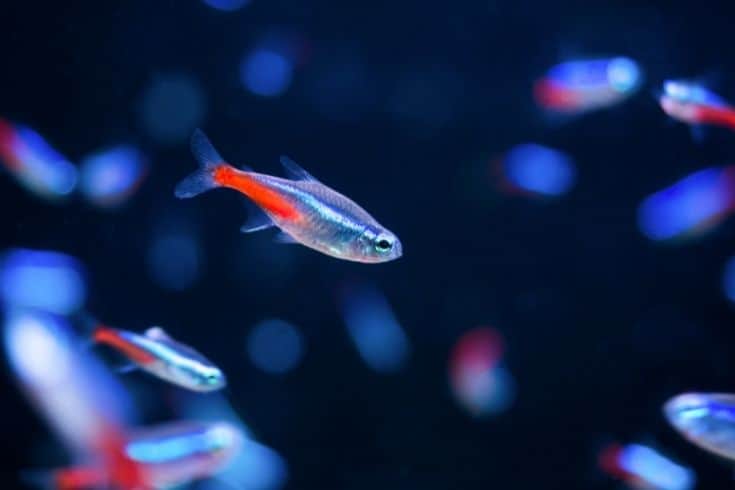
- Maximum size: 1.25 inches
- Life expectancy: 3 to 4 years
- Minimum tank requirement: 10 gallons
- Water temperature: From 68° to 78° Fahrenheit
- Care level: Easy
Neon tetras are regarded as the jewels of the fishkeeping hobby. With their glittering, iridescent blue coloring and brilliant red tail, these gorgeous little fishes look absolutely stunning when kept in schools of six or more individuals.
Neons do best in a heavily planted tank with subdued lighting and lots of hiding places, such as caves, driftwood, etc. Provide plenty of open water, too, as these fish like to hang out in the midwater area of the aquarium, creating a breathtaking display of shimmering color as they shoal together. Neon tetras are peaceful little fishes that can be kept in a community setup with other small, non-aggressive tankmates.
Neons are omnivorous, thriving on a diet of tropical flake food and micro-pellets supplemented with frozen food, such as bloodworms, brine shrimp, and mosquito larvae. When fed a good quality diet and kept in the right conditions, these fish will spawn readily.
3. Golden Wonder Killifish
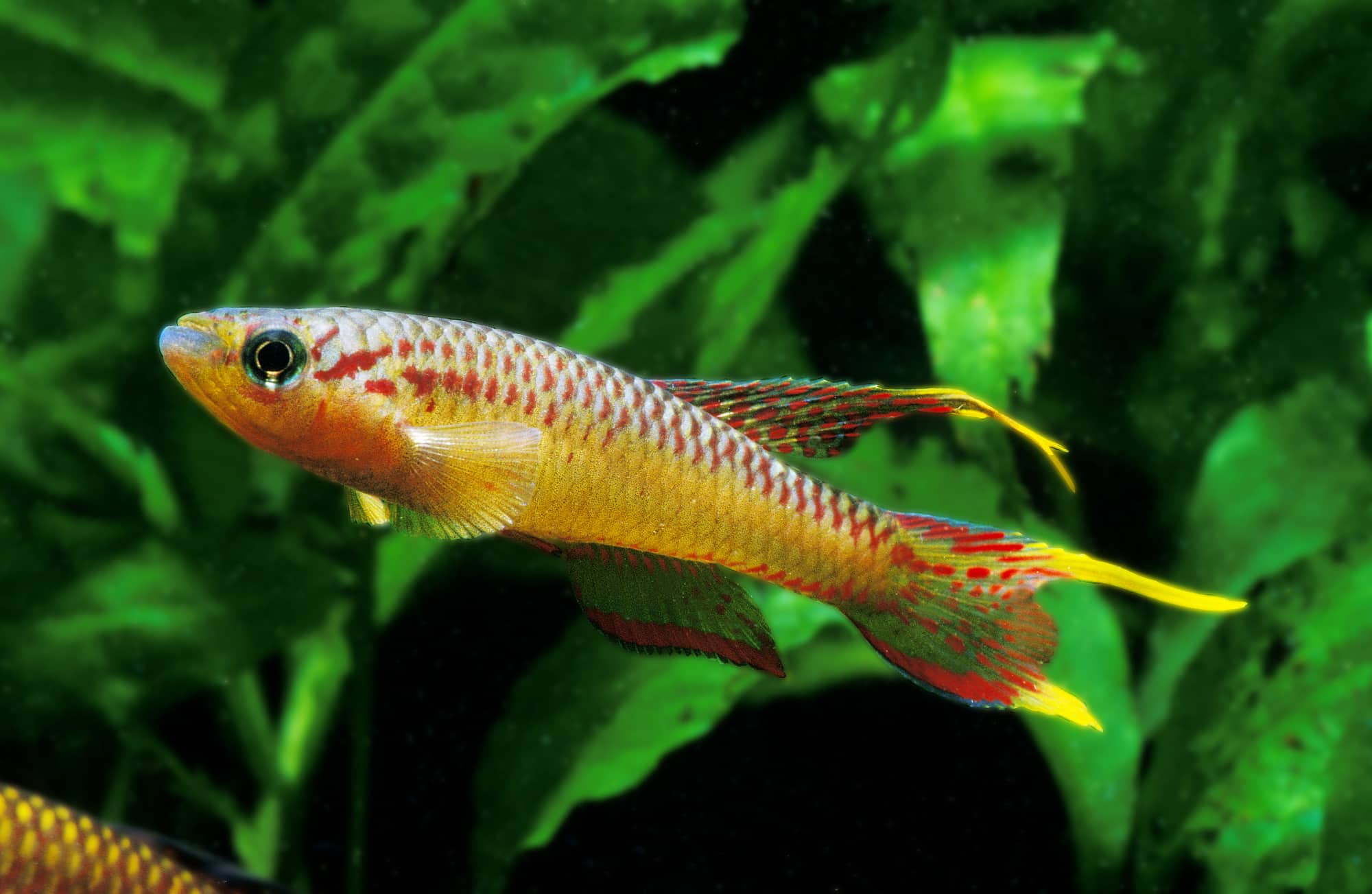
- Maximum size: 4 inches
- Life expectancy: 3 to 4 years
- Minimum tank requirement: 20 gallons
- Water temperature: From 72° to 75° Fahrenheit
- Care level: Easy
Golden Wonder Killifish are native to the brackish and freshwater streams, marshes, and ponds of Africa, and their name, Killy, is taken from the Dutch for channel or ditch.
These carnivorous fishes are brightly colored with blue to yellow body coloration augmented by brilliant orange stripes and spots. Killifish are easy to look after and are tolerant of a wide range of water conditions, although they do prefer soft, slightly acidic water and are happiest in a heavily planted tank.
Golden Wonder Killifish are carnivores, eating most live foods, including tubifex, white worms, and brine shrimp, and they will also accept some frozen and flake foods.
4. Kuhli Loach
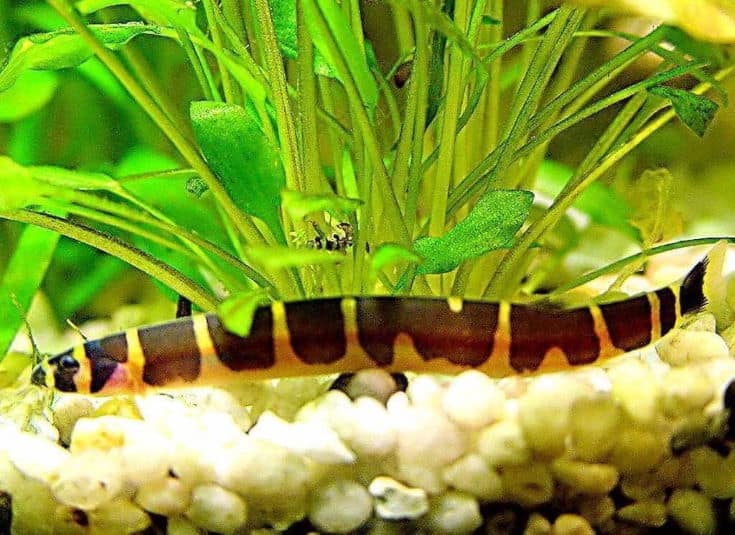
- Maximum size: 4.5 inches
- Life expectancy: Up to 14 years
- Minimum tank requirement: 50 gallons
- Water temperature: From 79° to 86° Fahrenheit
- Care level: Moderate
The Banded Khuli loach is one of around 100 species that belong to the Cobitidae family. These fishes are primarily carnivorous, living on the substrate and scavenging. Loaches are scaleless fish, and that can leave them susceptible to attack by parasites and some bacterial diseases too.
Loaches are shy fish that need an environment with plenty of hiding places and thick planting. These nocturnal fishes are peaceful, getting along well with other benign community species.
Feeding these fish can be challenging, as they do prefer a live diet, although they do accept freeze-dried tubifex and bloodworms, and they will take frozen meaty foods too. If you invest time in training your loaches, they will eventually learn to accept tropical flake foods, too.
5. American Flagfish
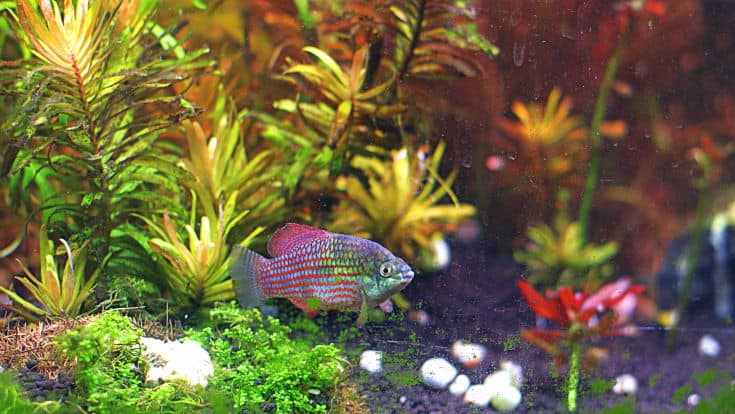
- Maximum size: 2.5 inches
- Life expectancy: 2 to 3 years
- Minimum tank requirement: 10 gallons
- Water temperature: From 66° to 72° Fahrenheit
- Care level: Easy
The American Flagfish is an easy-to-care-for killifish that is well-known for both its algae-eating services and its stunning colors.
The fish is named for the American flag, having alternating red and creamy green stripes running horizontally across its body and sparkling scales that are reminiscent of the stars on the flag. American Flagfishes thrive in community tanks and even in small outdoor ponds, preferring dense planting and cover provided by floating plants.
These gorgeous fish with their patriotic coloring feed on a diet of live foods, including white worms, brine shrimp, tubifex, frozen meaty foods, and tropical flakes. If you don’t have a lot of algae growing in your tank, you’ll need to supplement the American Flagfish’s diet with algae wafers.
6. Indian Glassfish
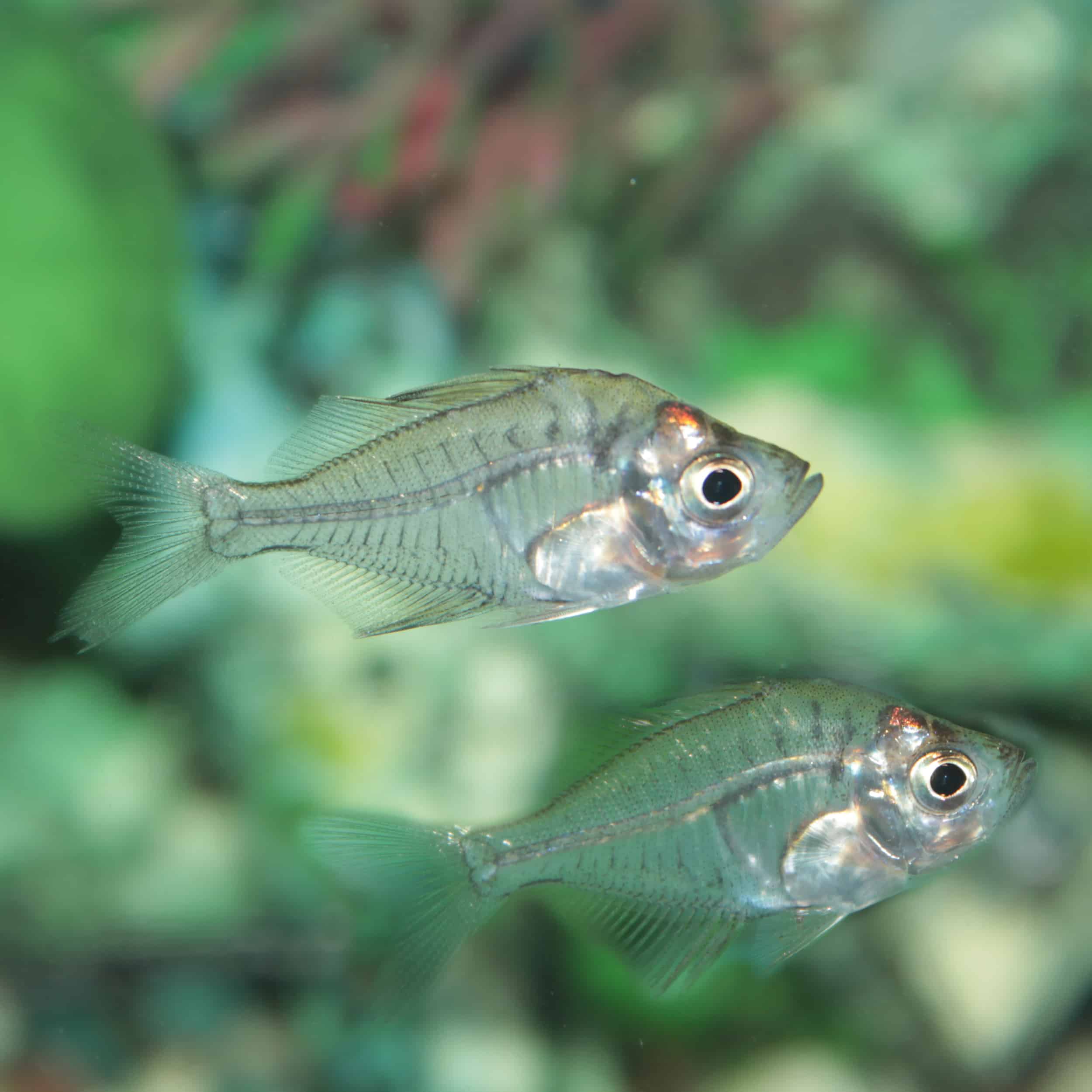
- Maximum size: 5 inches
- Life expectancy: 8 years
- Minimum tank requirement: 30 gallons
- Water temperature: From 72° to 80° Fahrenheit
- Care level: Moderate
Indian Glassfish comes from the clear forest streams of Myanmar. These unusual, almost transparent fishes are reasonably easy to care for, although they do need to live in a school in a well-oxygenated tank with excellent filtration and plenty of open water swimming space.
Glassfish are pretty peaceful characters, although they have been known to eat smaller tetras, so stock your aquarium with that in mind. These eye-catching fish are omnivorous, eating a variety of staple aquarium fish foods, including tropical flakes, pellets, fresh, or frozen foods.
7. Peacock Gudgeon
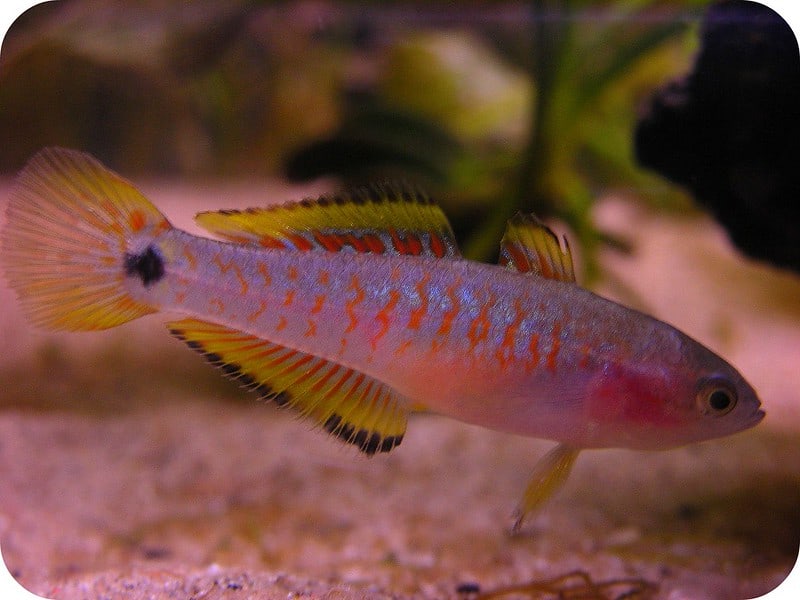
- Maximum size: 2.5 inches
- Life expectancy: 4 to 5 years
- Minimum tank requirement: 15 gallons
- Water temperature: From 72° to 77° Fahrenheit
- Care level: Easy
The Peacock Gudgeon is one of our favorite and coolest aquarium fish that you can enjoy in your home tank.
These gorgeous little fish are a riot of color, as well as being very easy to look after. Peacock Gudgeons are peaceable in nature, settling in well in a community setup, biotope, or planted tank. Also, you can breed these egg-laying fish relatively easily, provided that the tank is well-decorated and has excellent filtration. Once the eggs are laid, you can enjoy watching the male fish guarding them until the fry hatches.
The Peacock Gudgeon is omnivorous, enjoying a diet of flake food, frozen and freeze-dried meaty protein foods, including brine shrimp and bloodworms.
8. Bristlenose Plecostomus
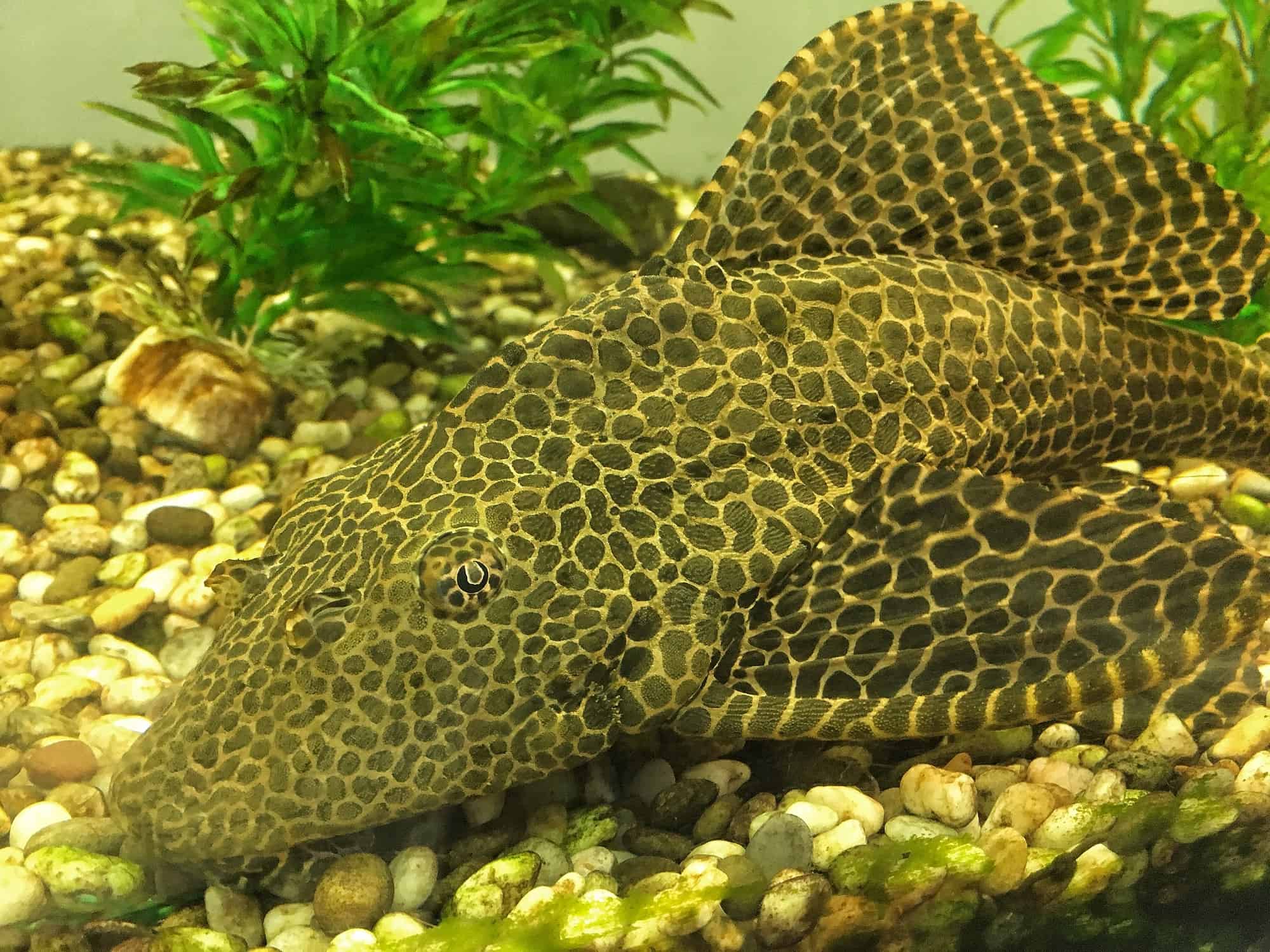
- Maximum size: 5 inches
- Life expectancy: 5 years
- Minimum tank requirement: 30 gallons
- Water temperature: From 74° to 79° Fahrenheit
- Care level: Easy
The Bristlenose Plecostomus is a species of peaceful freshwater catfish that makes a quirky addition to any large community tank. These fish come in a variety of colors and patterns, including black and albino.
Plecos need a well-oxygenated tank with highly efficient filtration and good water movement. Provide lots of hiding places, rocks, driftwood, and heavy planting to keep these guys happy. You can breed Bristlenose Plecos in the home tank, and watching the male fish guarding his eggs and fry is fascinating, especially for kids.
These omnivorous fish are not fussy eaters, deriving much of the nutrition they need from algae and by scavenging scraps from the substrate. That said, you should also supplement that diet with flake foods and algae wafers.
9. Bolivian Ram
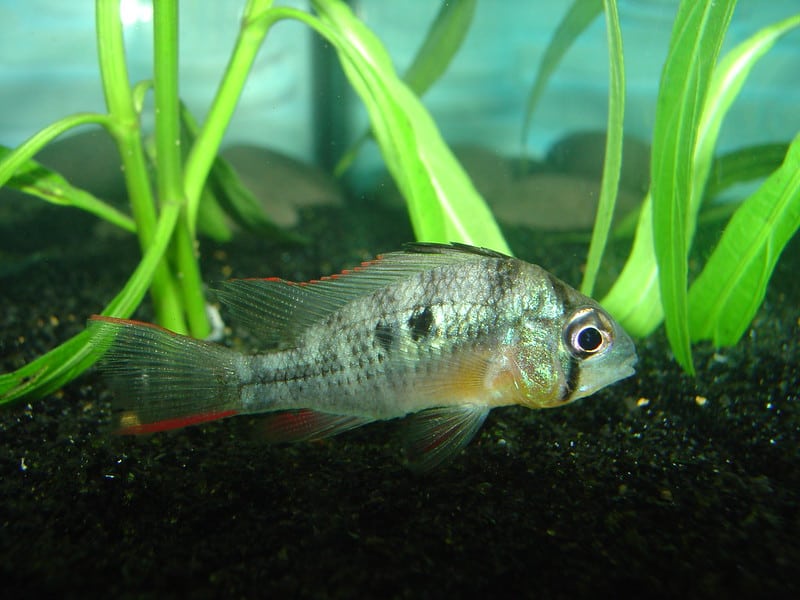
- Maximum size: 3 inches
- Life expectancy: 4 years
- Minimum tank requirement: 30 gallons
- Water temperature: From 72° to 79° Fahrenheit
- Care level: Experienced Only
The Bolivian Ram is also known as the Red Ram or Butterfly Ram. These peaceful sociable fish make a great addition to a large tank but are not the easiest to care for, so we recommend that only experienced hobbyists take on this species.
In the aquarium, these guys need lots of open water swimming space, as well as plenty of lush planting and some caves in which to spawn. Bolivian Rams pair for life, and they can be encouraged to spawn in a home tank, provided that conditions are right. Once the eggs are laid, both parents take turns raising the fry.
These fish are omnivorous, taking a wide range of foods, including flakes, frozen food, freeze-dried bloodworms, and live brine shrimp.
10. Powder Blue Dwarf Gourami
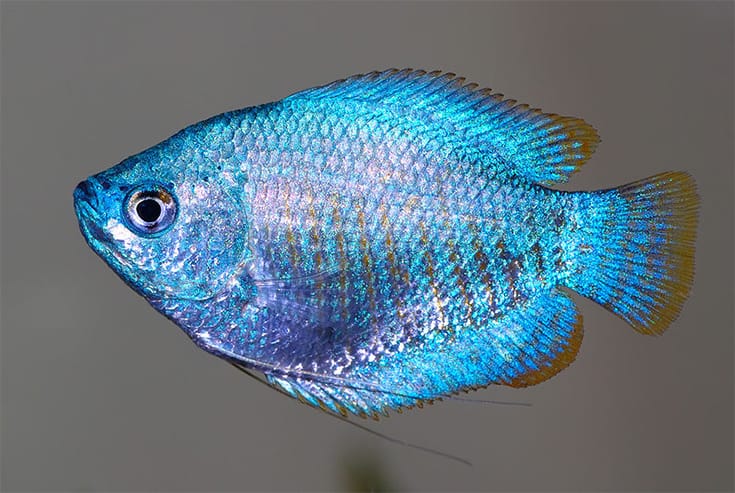
- Maximum size: 3.5 inches
- Life expectancy: 4 to 6 years
- Minimum tank requirement: 10 gallons
- Water temperature: From 72° to 82° Fahrenheit
- Care level: Easy
Powder Blue Dwarf Gouramis are a color variant of the regular Dwarf Gourami. I have these in one of my tanks, and they are my personal favorites.
These peaceful, labyrinth fish make an excellent addition to a community tank, preferring lots of planting and floating plants too, and they are extremely easy to look after. That said, you do need an efficient filtration system and you must keep the tank clean, as Powder Blue Dwarf Gouramis will become stressed if conditions deteriorate.
If the water temperature is kept at the upper end of the Gourami’s preferred range, they will spawn readily, building bubble nests and establishing territories in the tank. Male fish guard the eggs and raise the fry, which is fun to watch.
These fish eat a mixture of algae-based foods, as well as meaty proteins such as frozen or freeze-dried bloodworms, brine shrimp, and tubifex.
11. Roseline Torpedo Shark
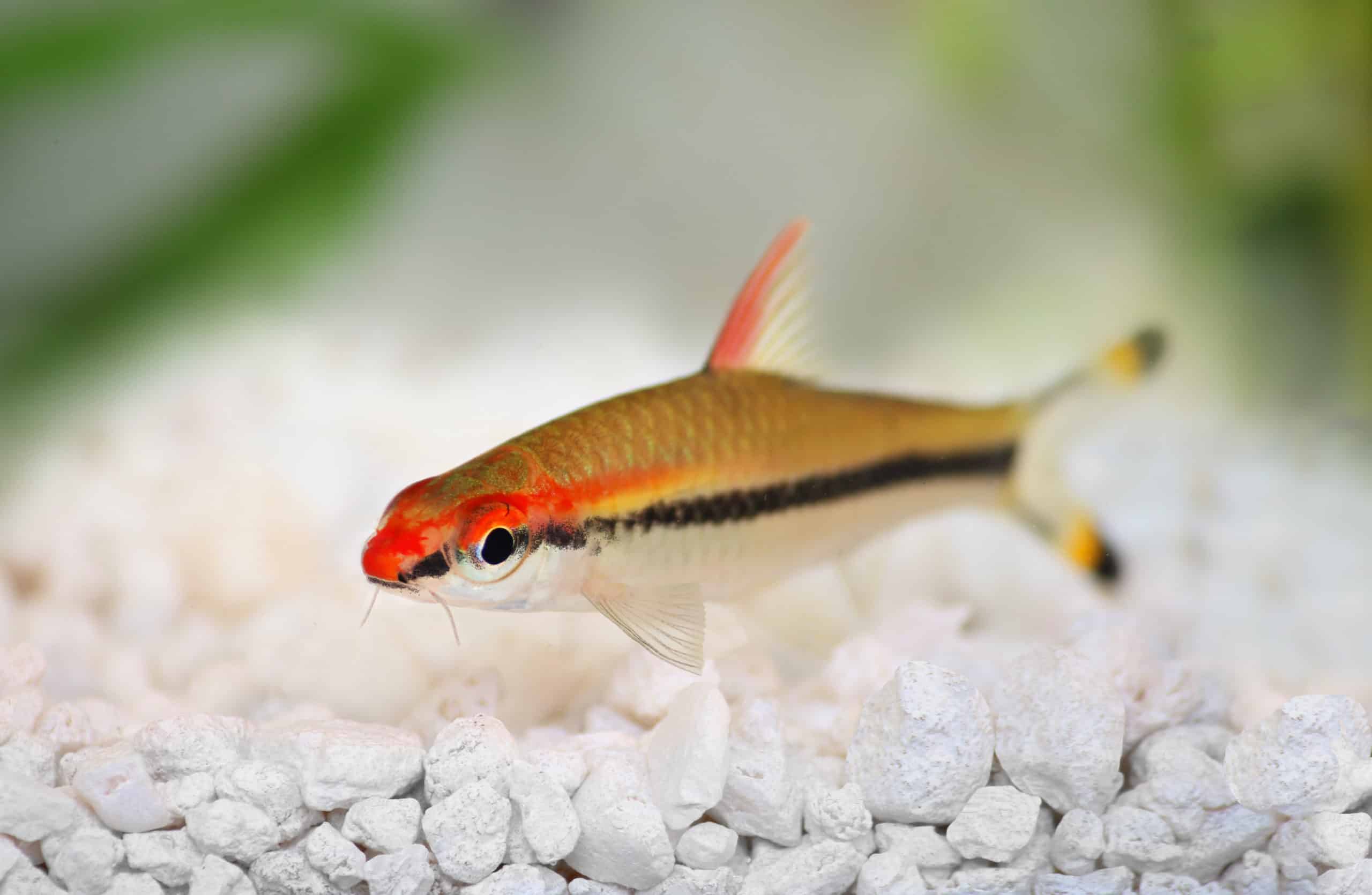
- Maximum size: 4.5 inches
- Life expectancy: 4 to 6 years
- Minimum tank requirement: 50 gallons
- Water temperature: From 60° to 77° Fahrenheit
- Care level: Easy
The Roseline Torpedo Shark is also known as the Denison Barb and Red Lined Torpedo Shark. Unlike some of the other barb species, these are peaceful characters that make a pretty addition to a large community tank.
Keep these fishes in small schools in a tank that has a tightly fitting lid, as they do jump. You’ll need a setup with a decent flow to replicate the fast-moving streams in which the Roseline Torpedo Shark is found in nature, and dissolved oxygen levels in the water should be high.
These active freshwater sharks enjoy an omnivorous diet of flaked food and meaty protein in the form of frozen brine shrimp, bloodworms, and similar.
12. Crowntail Betta Fish
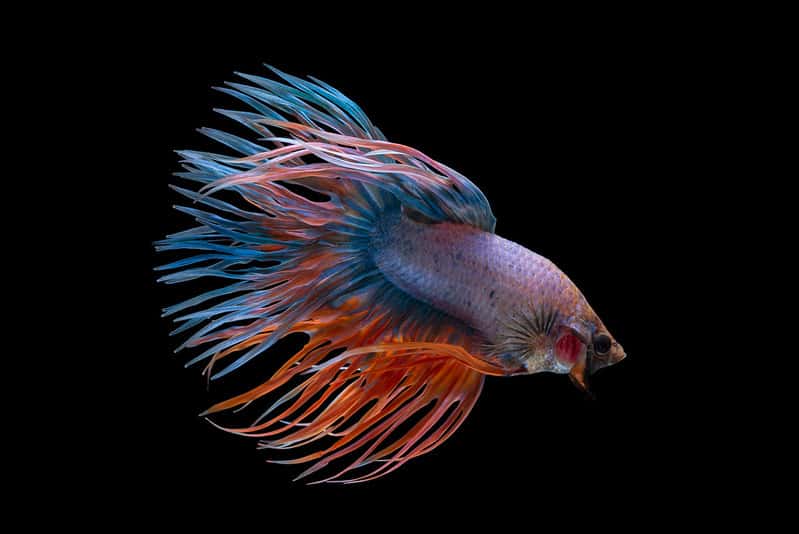
- Maximum size: 2.5 inches
- Life expectancy: 4 years
- Minimum tank requirement: Nano tank
- Water temperature: From 75° to 86° Fahrenheit
- Care level: Easy
If you want to enjoy keeping a striking feature fish that has the personality to match his good looks, you need a Crowntail betta!
Betta fish don’t need a huge tank to be happy but these intelligent creatures do need plenty of stimulation in the form of toys, plants, caves, and other decorations. Bettas are sensitive to sudden fluctuations in temperature, and you need an efficient filtration system to keep the water clean.
You can’t keep two male betta fish together, but most individuals will be fine when kept in a peaceful community of fish of a similar size. Bettas are labyrinth fish, and they also construct bubble nests. I kept a small sorority of female bettas with my male Crowntail, and they spawned readily in my tank, which is good news if you fancy breeding bettas.
These fish are primarily carnivorous, although mine did enjoy grazing on algae too. Feed your betta high-quality flake food, as well as freeze-dried and frozen bloodworms, brine shrimp, and mosquito larvae.
13. Koi Angelfish
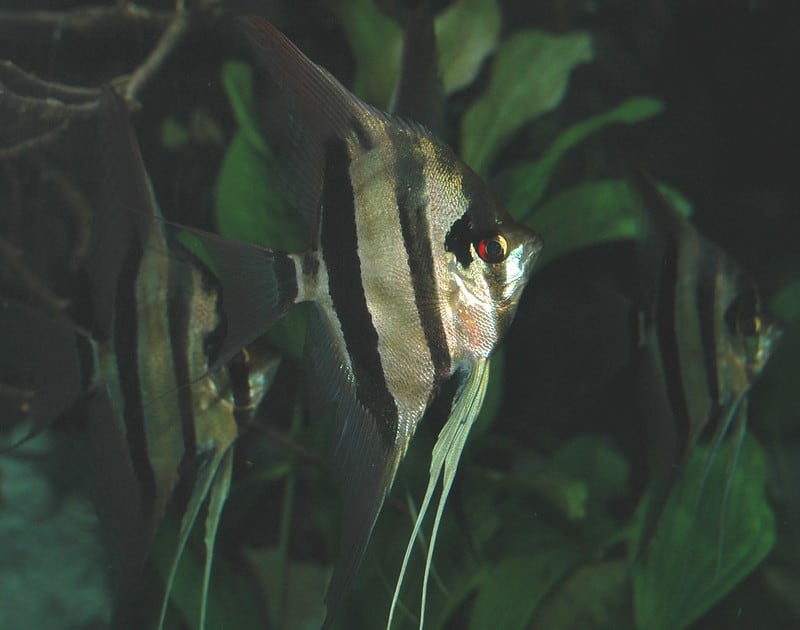
- Maximum size: 6 inches
- Life expectancy: 10 years
- Minimum tank requirement: 30 gallons
- Water temperature: From 75° to 82° Fahrenheit
- Care level: Easy
Koi Angelfish are a stunning variety of angelfish that are each unique in color and pattern.
These fish are happiest when kept in small schools, and they will pair off as they mature. As semi-aggressive fish, Koi Angelfish are best kept in single-species setups or with other fish of a similar size and nature.
Angelfish are quite large, and they do need lots of swimming space, as well as rocks, driftwood, and plants in their setup. The flow through the tank should be moderate, and you’ll need to keep the water pristine for these guys to thrive.
Koi Angelfish are omnivores, feeding on a variety of food, including meaty protein, tropical flake, and frozen and live foods, including bloodworms and brine shrimp.
14. Royal Whiptail Catfish

- Maximum size: 6 inches
- Life expectancy: 4 years
- Minimum tank requirement: 50 gallons
- Water temperature: From 73° to 79° Fahrenheit
- Care level: Moderate
The Royal Whiptail catfish is an armored catfish with a long, slender tail and an elongated nose. These totally cool fish have a sucker mouth that they use to feed on algae, helping to keep your plants and decorations clean. These helpful fish are peaceful creatures that make an excellent addition to a community setup.
You do need a large tank for these guys that has plenty of hiding places, including plants, rocks, and driftwood. These bottom-dwelling omnivorous fishes eat fish flake, freeze-dried bloodworms, sinking herbivore pellets, algae, and leftover food that drifts down from above.
15. Agassiz’s Dwarf Cichlid
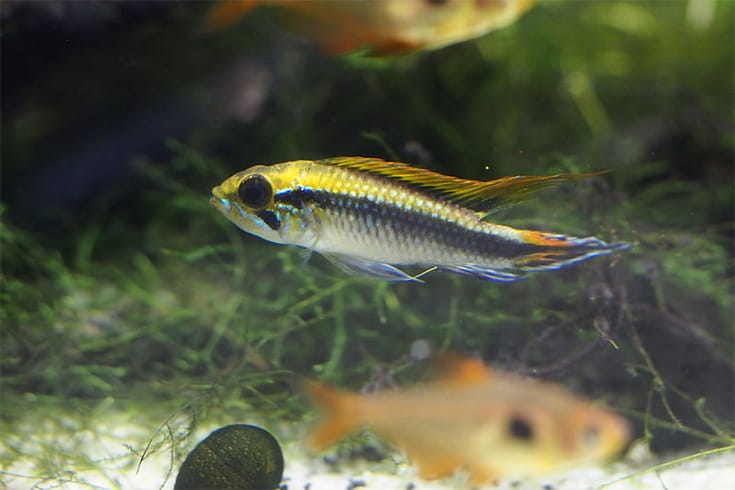
- Maximum size: 3 inches
- Life expectancy: 5 years
- Minimum tank requirement: 30 gallons
- Water temperature: From 77° to 82° Fahrenheit
- Care level: Moderate
If you’re a fan of cichlids, you’ll agree that Agassizii’s Dwarf Cichlid is a stunner!
These gorgeous little fish need a tank that’s densely planted, and that has a stable environment with very good water quality. Lots of open swimming areas are also preferred, with hiding places and a sandy or fine gravel substrate. If you want to encourage spawning, you’ll need to include caves in your tank decorations.
Although these fish can be kept in a community, they are quite a shy species and shouldn’t be kept with large or semi-aggressive fish.
Agassizii Dwarf Cichlids eat flake foods, micro pellets, frozen bloodworms, Mysis shrimp, and similar.
16. Honey Gourami
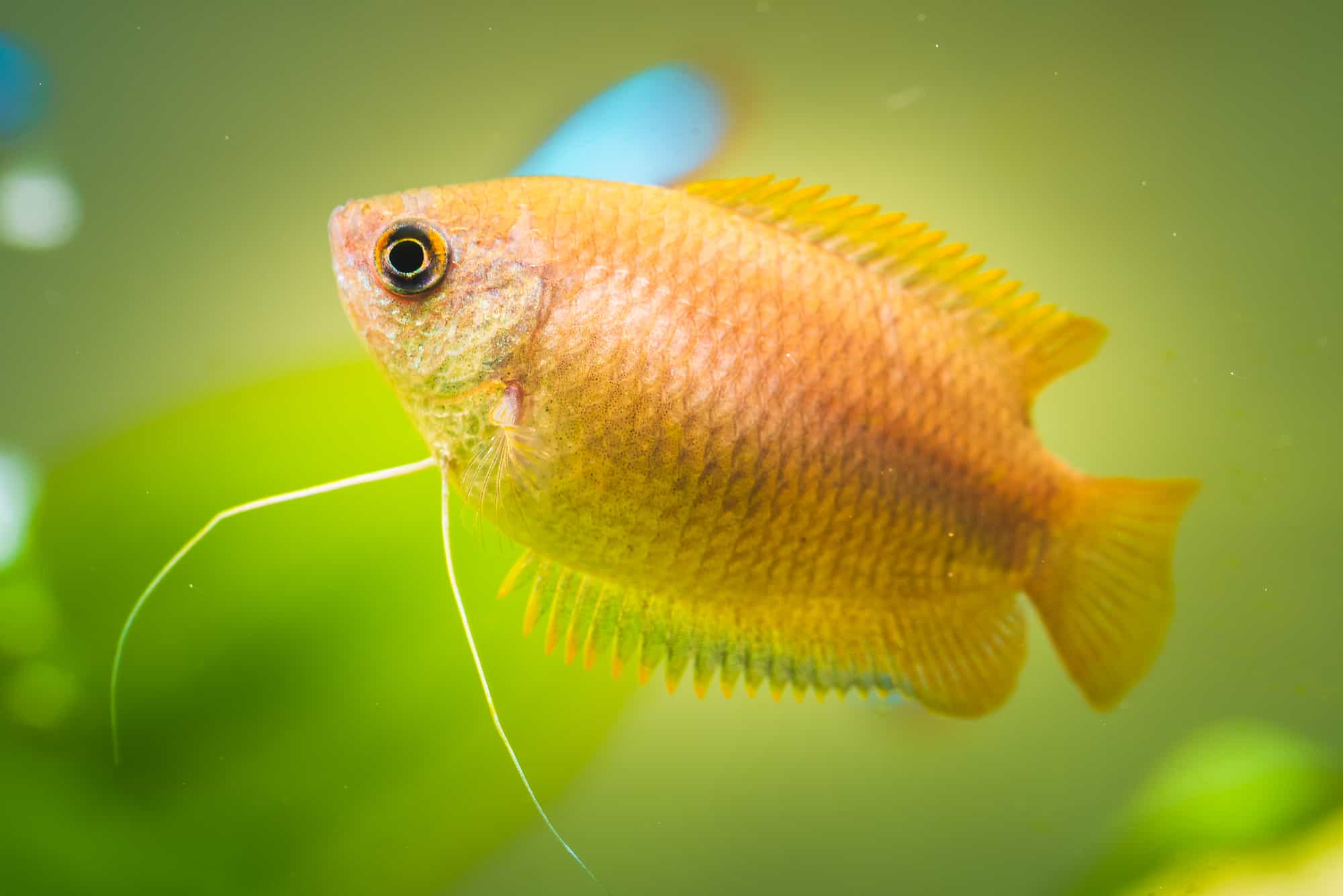
- Maximum size: 2 inches
- Life expectancy: 4 to 8 years
- Minimum tank requirement: 10 gallons
- Water temperature: From 72° to 82° Fahrenheit
- Care level: Difficult
The Honey Gourami or Trichogaster chuna is a close relative of the Dwarf Gourami. These are labyrinth fish that enjoy life in a heavily planted tank that includes floating plants. Honey Gouramis are peaceful fishes that make good community residents, although they can become territorial when spawning.
These fish are not the easiest to keep healthy, and for that reason, we don’t recommend them to beginner hobbyists. The Honey Gourami is an omnivore, eating vegetable and algae-based foods, as well as meaty proteins, including frozen and freeze-dried tubifex, bloodworms, and brine shrimp.
17. Boeseman’s Rainbowfish
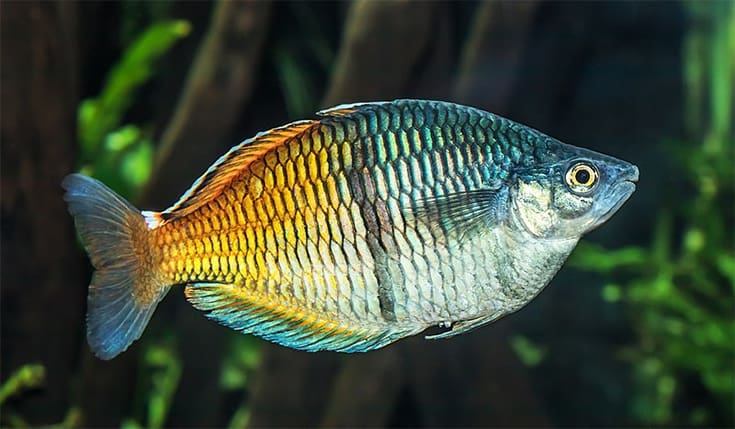
- Maximum size: 4 inches
- Life expectancy: 5 to 8 years
- Minimum tank requirement: 30 gallons
- Water temperature: From 72° to 77° Fahrenheit
- Care level: Easy
The Boesemani Rainbowfish is a beautiful fish that looks absolutely gorgeous when displayed in a school in a heavily planted aquarium with a dark substrate and plenty of rockwork. Give these fishes plenty of swimming space in a long aquarium, and you will create a jaw-dropping spectacle. Rainbowfish are peaceful creatures that can also do well in a community tank.
Despite their exotic appearance, these omnivorous rainbowfishes are very easy to care for, and they will spawn readily, too, if given the right conditions and a suitable diet. Like all rainbowfish, Boesemanis have very large mouths, but their throats are narrow. For that reason, you should offer fish foods that are small enough to be easily swallowed. Feed tropical flakes, live, and frozen meaty foods.
18. Red Wagtail Platy
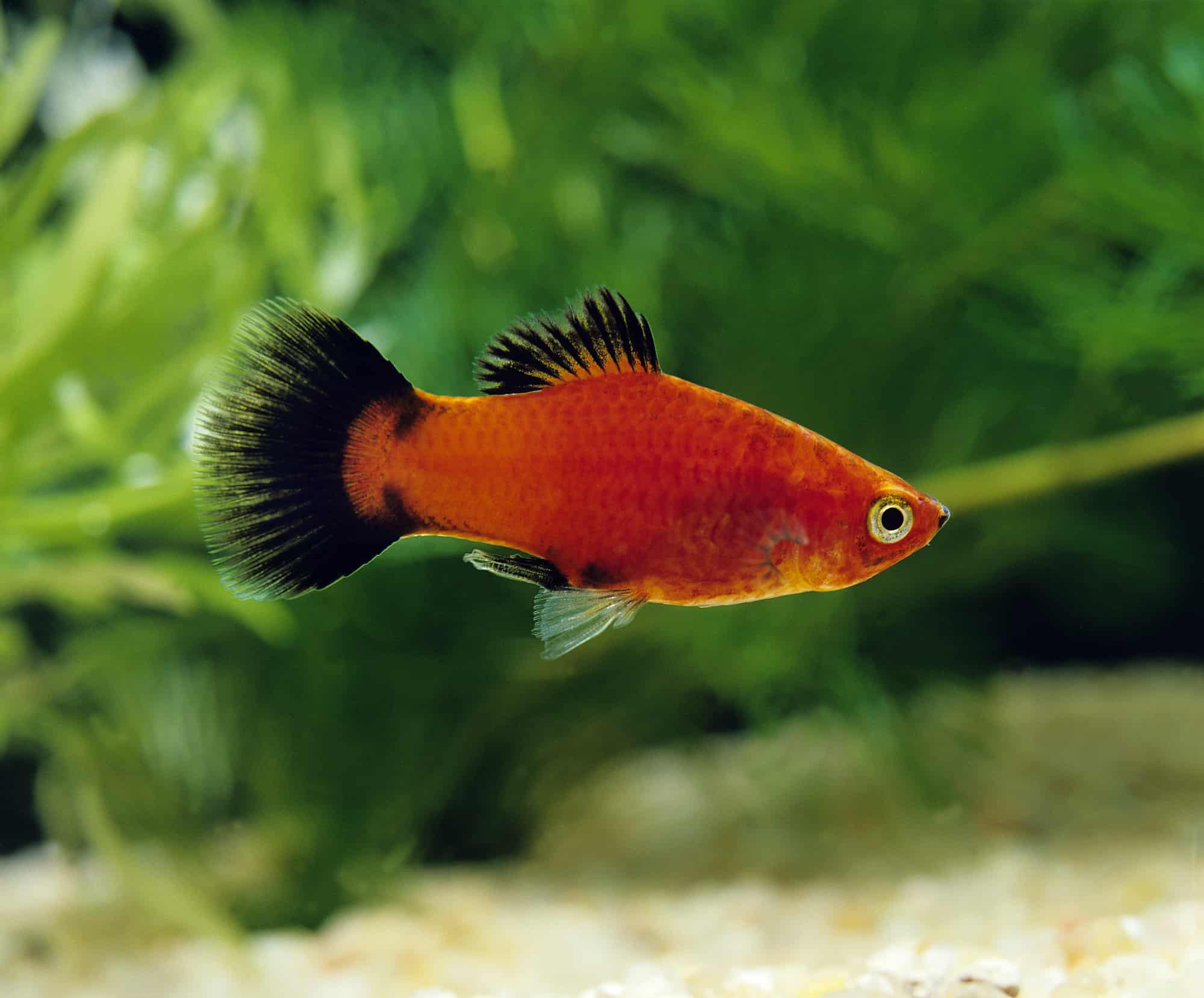
- Maximum size: 2 inches
- Life expectancy: up to 3 years
- Minimum tank requirement: 10 gallons
- Water temperature: From 64° to 77° Fahrenheit
- Care level: Easy
The Platy is a popular favorite that’s ideal for beginners, being easy to care for and extremely quick to reproduce in the home tank. Red Wagtail Platys are a variation that adds a brilliant splash of color to a peaceful community aquarium. These fish are ideal for kids’ pets, as they don’t need a huge tank and are tolerant of a variety of water conditions.
These lively, sociable fish can be kept in large schools in a bigger tank to create a spectacular, colorful display. And thanks to their rapid rate of reproduction, you could start with just a few fish and breed your own stock.
Platys are omnivores that will thrive on flaked foods, algae, and a range of freeze-dried, frozen, and live meaty foods, such as bloodworms, brine shrimp, and tubifex.
19. Boraras Brigittae
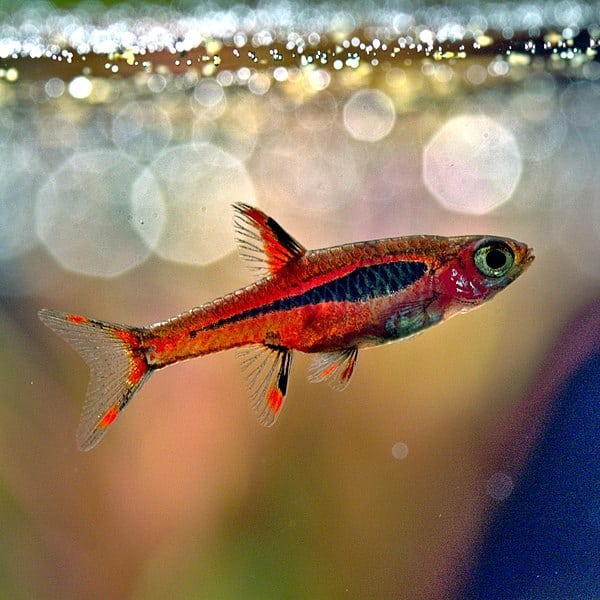
- Maximum size: 2 inches
- Life expectancy: up to 3 years
- Minimum tank requirement: 10 gallons
- Water temperature: From 72° to 77° Fahrenheit
- Care level: Easy
Boraras Brigittae is a variety of rasbora that is one of the less commonly seen varieties of these popular tropical fish.
These peaceful omnivores should be kept in schools of eight to ten individuals and make a nice addition to a community setup of similar-sized, small fishes. Boraras Brigittae likes a mature setup that has plenty of planting but also includes open areas for swimming.
If fed a good quality diet of tropical flake food, freeze-dried and frozen proteins such as bloodworms, brine shrimp, and tubifex, these pretty rasboras will spawn in your tank.
20. Glass Catfish
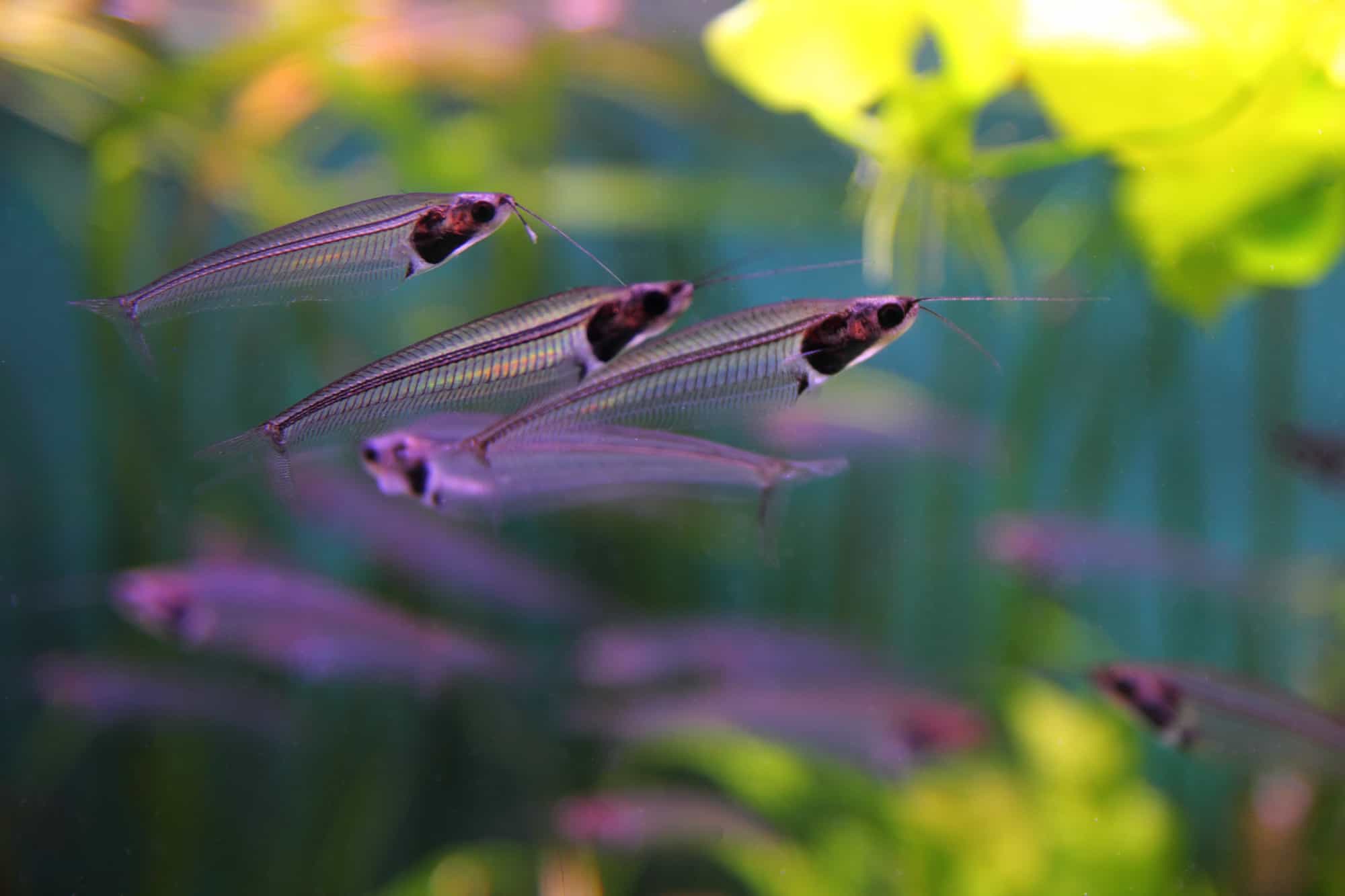
- Maximum size: 4 inches
- Life expectancy: up to 8 years
- Minimum tank requirement: 30 gallons
- Water temperature: From 75° to 80° Fahrenheit
- Care level: Moderate
Ghost Glass Catfish are such cool fish! These weird creatures are totally transparent, enabling you to see the fish’s internal organs and skeleton.
These are peaceful fish that can be kept in a community tank with other species of a similar size and temperament. That said, Ghost Glass Cats are schooling fish that must be kept in a group of at least five individuals if they are to thrive. If kept alone, these fish will become stressed, stop eating, and die.
These fish prefer to be kept in low-light conditions and are most lively at dusk and dawn. Provide the Ghost Glass Catfish with plenty of caves, coves, and hiding places, as well as abundant dense planting.
These fishes are omnivorous, preferring a diet of tropical flake and frozen food, as well as freeze-dried treats of tubifex and bloodworms.
21. Cyrtocara Moorii
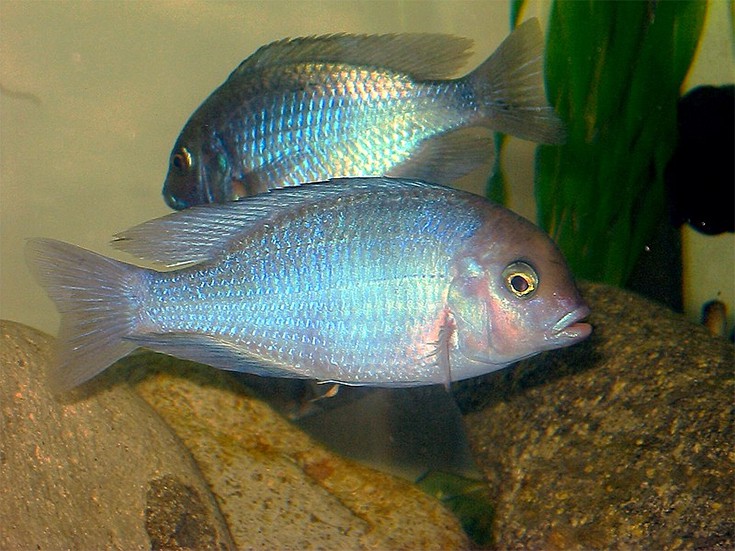
- Maximum size: 9.8 inches
- Life expectancy: up to 8 years
- Minimum tank requirement: 75 gallons
- Water temperature: From 73° to 82° Fahrenheit
- Care level: Intermediate
In nature, the Cyrtocara Moorii is a semi-aggressive, carnivorous predator and, as such, isn’t suitable for life in a community tank unless kept with other cichlid species of a similar disposition and size. These big cichlids need a very large tank with plenty of space for swimming and shoaling.
These are shoaling fish that need hard, alkaline water to thrive. Also, you’ll need to use a very efficient filtration system and carry out weekly water changes to keep the tank in pristine condition. These are carnivorous fish in nature and must be fed a meaty diet that includes live foods as well as frozen items. Also, you can cut up fresh prawns and earthworms, both of which make a good supplement to the Cyrtocara Moorii’s diet.
22. Flowerhorn Cichlid
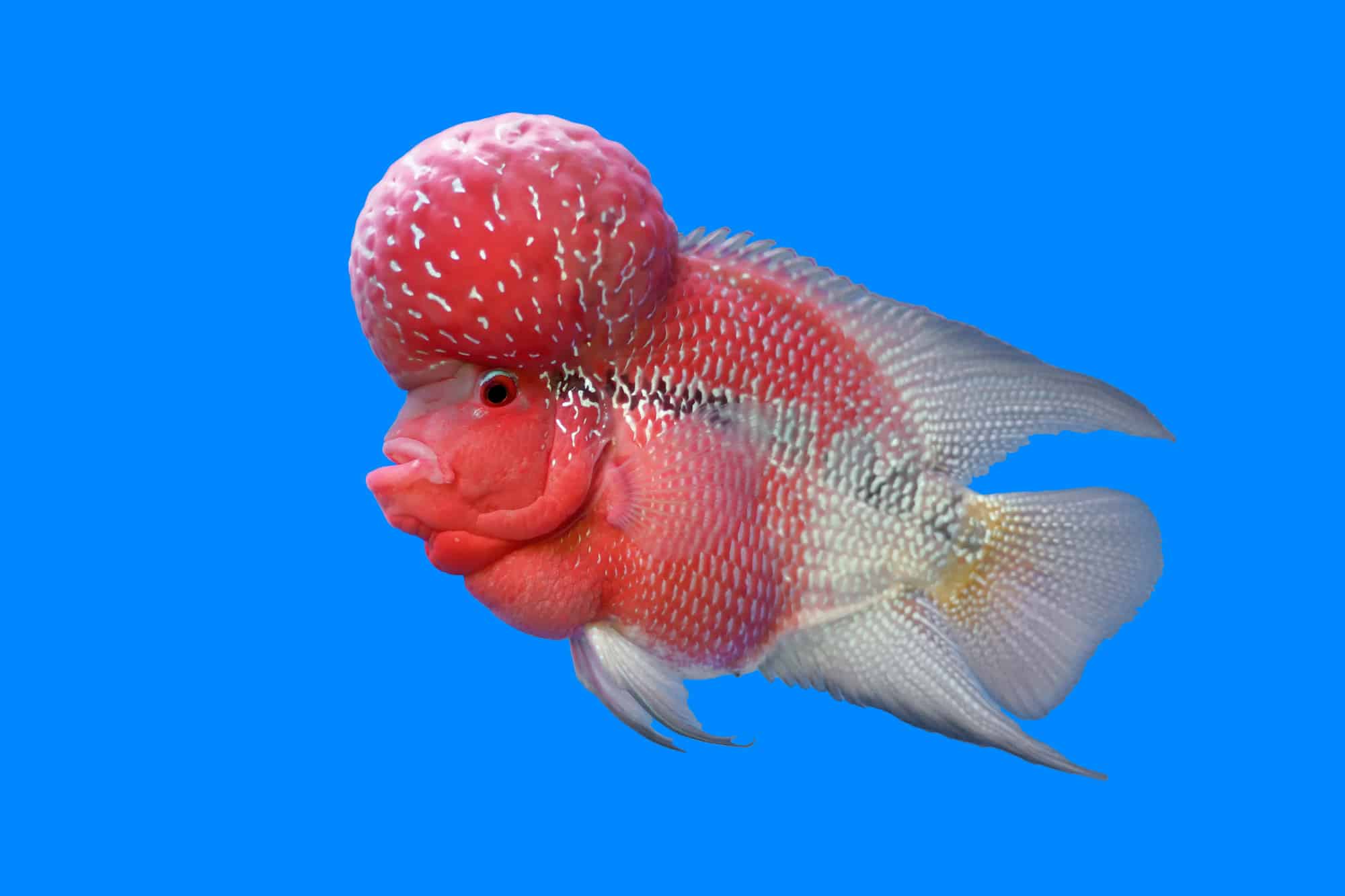
- Maximum size: 10 inches
- Life expectancy: up to 12 years
- Minimum tank requirement: 50 gallons
- Water temperature: From 72° to 80° Fahrenheit
- Care level: Easy
If you have a very large tank and you’re looking for a cool fish that has a distinctive appearance, look no further than the Flowerhorn Cichlid, so named for the brightly colored hump that grows on the fish’s head.
These are big fish, and they can be destructive in a planted tank, so any live plants must be secured in pots to protect their roots from the digging activities of the Flowerhorn. This cichlid species likes lots of hiding places among rocky terrain, and the substrate of the tank should be sandy to allow the fish to dig without sustaining an injury.
The Flowerhorn is quite aggressive and is not suitable for life in a peaceful community tank, as they will eat invertebrates and smaller fish species. Feed these omnivores a diet of cichlid pellets, flake foods, and frozen bloodworms, ocean plankton, and tubifex.
23. Black Molly
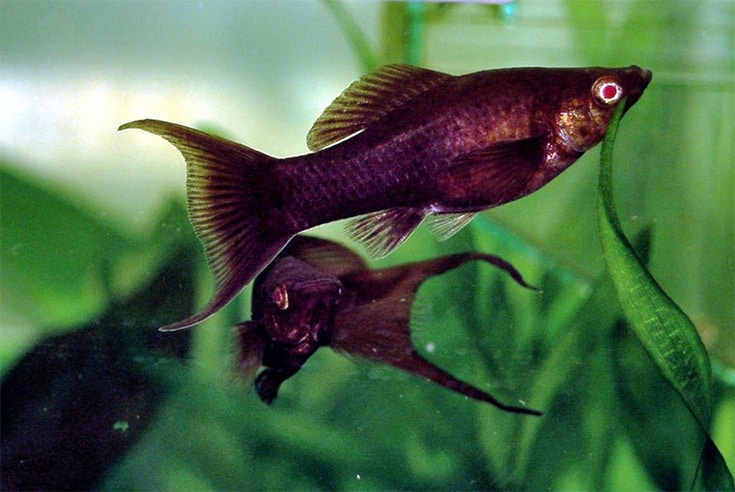
- Maximum size: 3 inches
- Life expectancy: up to 3 to 4 years
- Minimum tank requirement: 30 gallons
- Water temperature: From 68° to 82° Fahrenheit
- Care level: Intermediate
The Black Molly is an all-black variant of the Molly fish. Interestingly, although these are freshwater fish, they can acclimate to a brackish or even a saltwater tank. These peaceful, community-loving fishes prefer a tank with good filtration and lots of robust planting, including floating species.
These fish are livebearers, and they can be encouraged to spawn in captivity, although you’ll get the best results if you use a spawning tank. These omnivorous fishes do well on a varied diet of flakes, freeze-dried bloodworms, and frozen tubifex and brine shrimp.
24. Celestial Pearl Danio
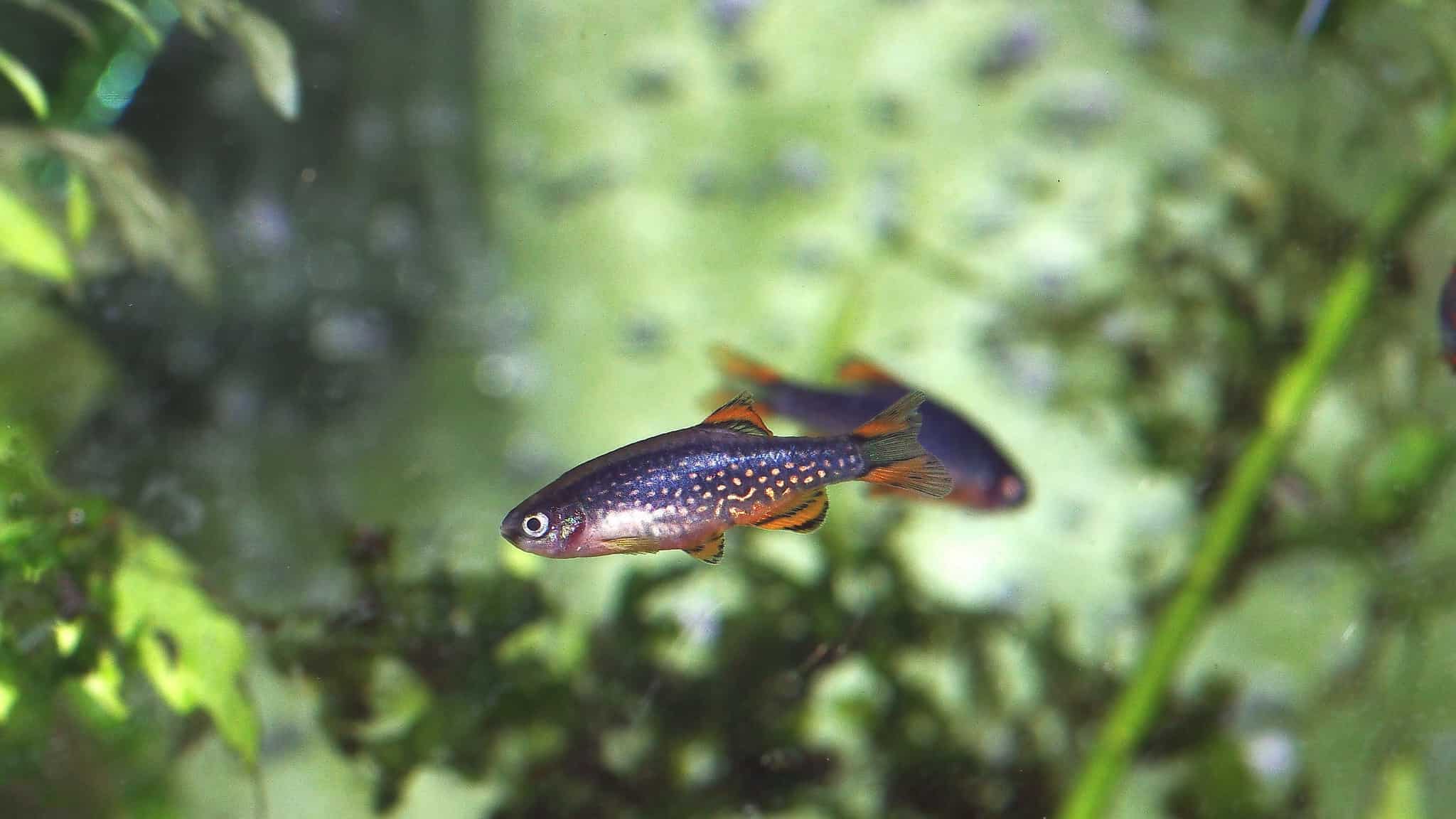
- Maximum size: 2 inches
- Life expectancy: up to 3 to 5 years
- Minimum tank requirement: 10 gallons
- Water temperature: From 73° to 77° Fahrenheit
- Care level: Easy
Celestial Pearl Danios are peaceful schooling fish that do well as part of a community with other good-natured fish of a similar size. These are very active fishes that enjoy plenty of swimming space surrounded by dense planting.
Pearl Danios are prolific breeders, and they will spawn readily in a shallow breeding tank that has a coarse gravel substrate on which they can scatter their eggs. To encourage spawning, feed the fish live foods and place the breeding tank where it will receive a small amount of sunlight.
These pretty little fishes are omnivorous, thriving on a diet of flake food, vegetable matter, and frozen foods, including bloodworms, brine shrimp, and tubifex.
25. Checkerboard Discus
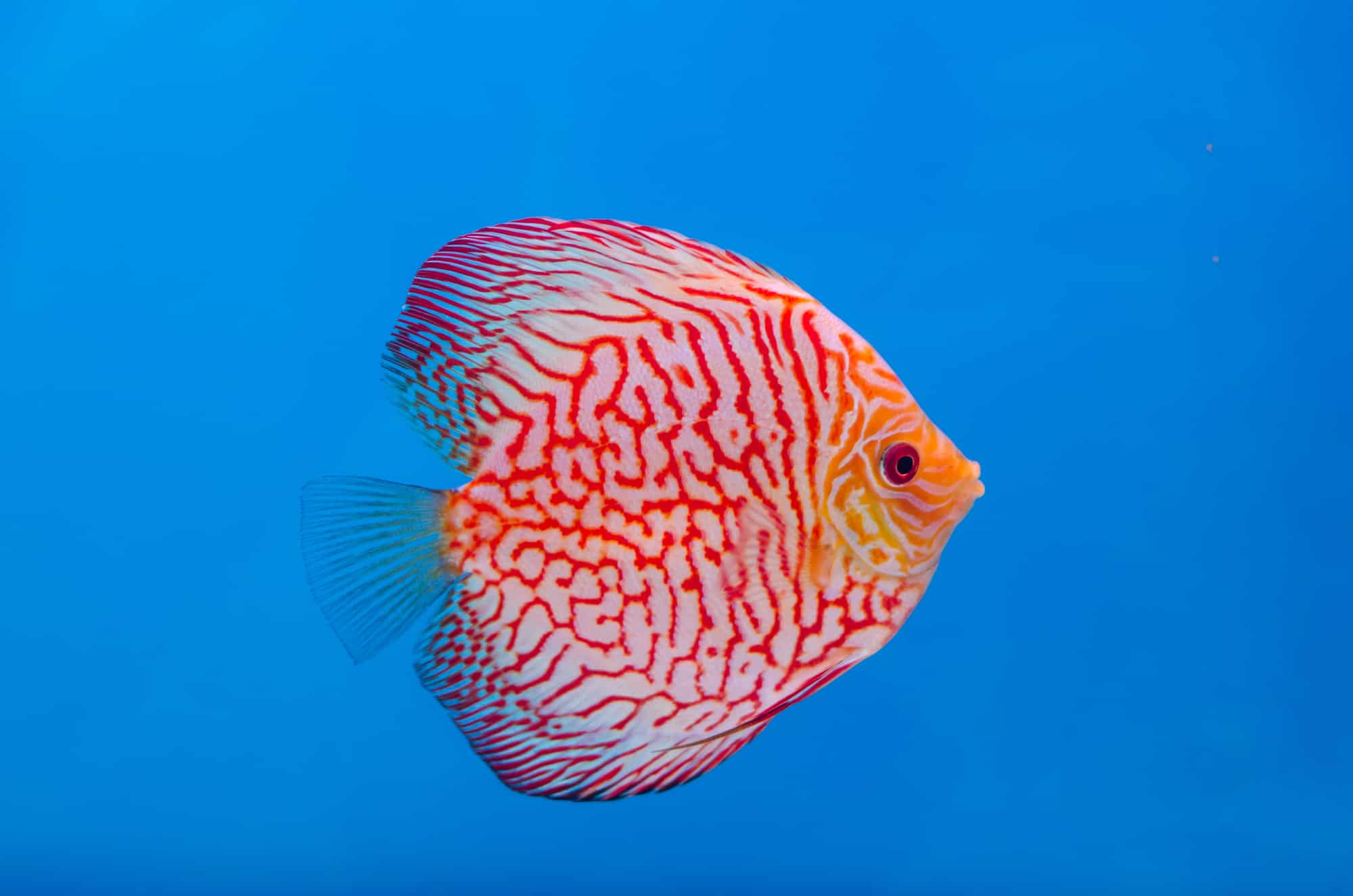
- Maximum size: 10 inches
- Life expectancy: up to 3 to 5 years
- Minimum tank requirement: 55 gallons
- Water temperature: From 79° to 86° Fahrenheit
- Care level: Intermediate
The Checkerboard Discus is a relatively new variety of the ever-popular Discus fish. These fish prefer a shady habitat with lots of dense covers and subdued lighting. For the fish to remain healthy, the water must be warm, acidic, and soft, and you’ll need a very efficient filtration system.
These peaceful carnivores can be kept in a community of other large fish, but they do best in a same-species setup where they can pair naturally. If you do decide to breed from your Checkerboard Discus, you should use a separate breeding tank, as this species can become territorial during breeding.
Discus are generally carnivorous, feeding on freeze-dried bloodworms and tubifex, discus pellets, frozen meaty foods, and high-quality flakes.
26. Pearl Gourami
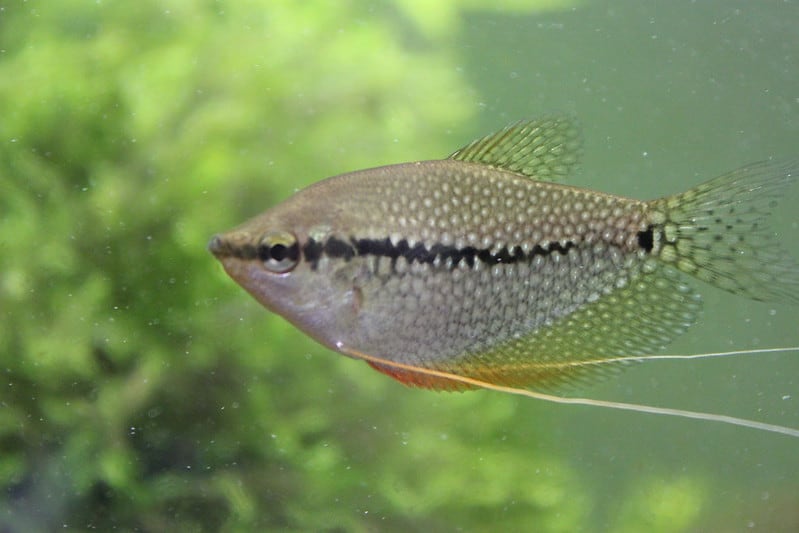
- Maximum size: 4 inches
- Life expectancy: up to 5 years
- Minimum tank requirement: 30 gallons
- Water temperature: From 75° to 86° Fahrenheit
- Care level: Easy
The beautiful Pearl Gourami is a cool fish that gives you plenty of bang for your buck in terms of looks while also being super-easy to keep.
You’ll need a fairly large tank that’s at least 12 inches deep, planted with lots of lush growth and floating plants that provide plenty of hiding places for these labyrinth fish. Pearl Gouramis are peaceful fishes that do well in a community setup with other good-natured species. Like other gourami species, the Pearl Gourami is a bubble nester that will spawn in captivity, provided that conditions are good.
Feed your fish a mixture of algae-based flake foods together with frozen and freeze-dried bloodworms, brine shrimp, and tubifex.
27. Bloodfin Tetra
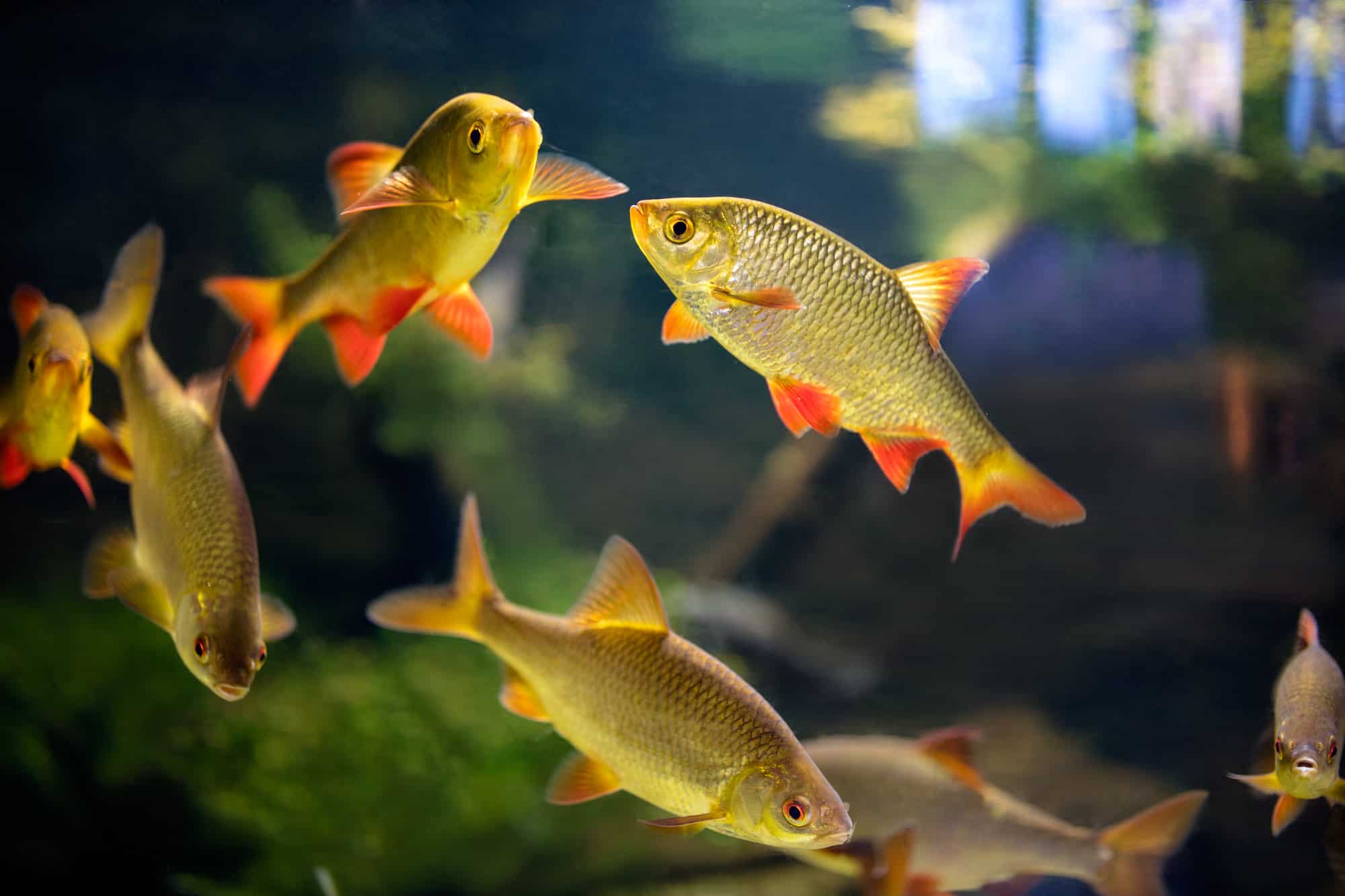
- Maximum size: 1.5 inches
- Life expectancy: up to 5 to 8 years
- Minimum tank requirement: 30 gallons
- Water temperature: From 72° to 80° Fahrenheit
- Care level: Easy
Bloodfin Tetras create a spectacular display when kept in schools in a nicely aquascaped tank containing plenty of plants, rocks, and driftwood. Leave plenty of swimming space in the midwater column, perhaps interspersed with tall plants.
These peaceful little fish make a nice addition to a community setup, although they shouldn’t be kept with aggressive species, or the shy tetras will hide, and you won’t get to enjoy them.
The Bloodfin Tetra eats most small foods, including daphnia, brine shrimp, freeze-dried bloodworms and tubifex, micro pellet food, and tropical flakes.
28. Swordtail
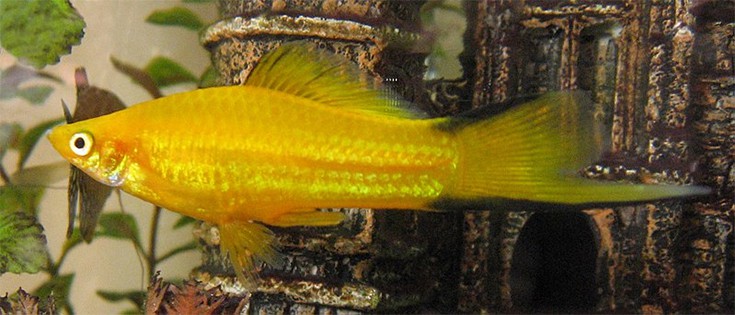
- Maximum size: 4 inches
- Life expectancy: up to 3 to 5 years
- Minimum tank requirement: 20 gallons
- Water temperature: From 64° to 82° Fahrenheit
- Care level: Easy
Swordtails come in a variety of colors that brighten up any community tank as these lively community fishes dart around the midwater column.
These fish are perfect for beginners, being easy to care for, peaceful in nature, and very easy to breed too. If you want any fry to survive, provide a spawning box or dense floating plants.
To get the best from these pretty little fishes you do need a reasonably sized aquarium with a tightly fitting lid to keep these confirmed jumpers from leaping out. Swordtails thrive on a diet of tropical fish flakes, algae, frozen meaty protein foods, freeze-dried bloodworms, and tubifex. You can also feed live brine shrimp if available.
29. Archer Fish

- Maximum size: 12 inches
- Life expectancy: up to 3 to 5 years
- Minimum tank requirement: 100 gallons
- Water temperature: From 77° to 82° Fahrenheit
- Care level: Difficult
The Archer Fish is a tropical, schooling species that can live in brackish or freshwater. These large fishes are best known for their habit of shooting down insects with a jet of water.
The ideal setup for these fascinating fish is a paludarium. That’s a tank that has plants extending above the water surface, as well as underwater life. The idea is that the setup encourages insects to settle on the plants, enabling the Archer Fish to indulge in its natural hunting behavior.
Feed these challenging fish tropical flakes, pellets, and frozen meaty foods too.
30. African Butterflyfish
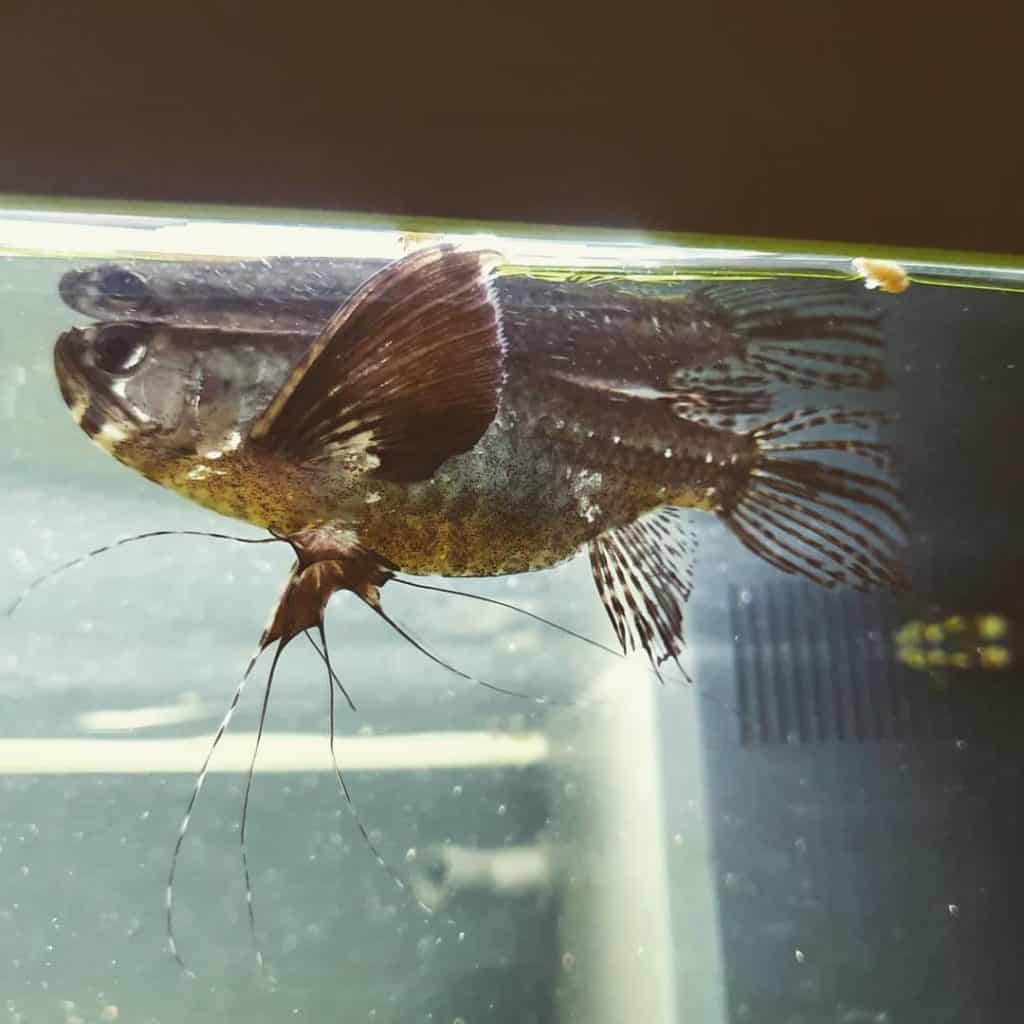
- Maximum size: 6 inches
- Life expectancy: 5 to 10 years
- Minimum tank requirement: 40 gallons
- Water temperature: From 73° to 86° Fahrenheit
- Care level: Intermediate
The African Butterflyfish, Pantodon buchholzi, is certainly one extremely cool dude in the fishy world!
These weird-looking fish are semi-aggressive carnivores that need a pretty large tank to accommodate them.
African Butterflyfish are native to the central Congo and lower Niger in West Africa, where they live in water bodies where the current is extremely slow, such as ponds, riverbanks, swamps, and lakes.
These fish are surface hunters, streamlined and equipped to glide through the air over short distances when necessary, either to escape predators or catch prey.
The African Butterflyfish has large pectoral fins that resemble those of a butterfly, hence the fish’s common name. Once airborne, the fish fans out the fins to maximize the surface area and literally fly!
31. Chocolate Gourami
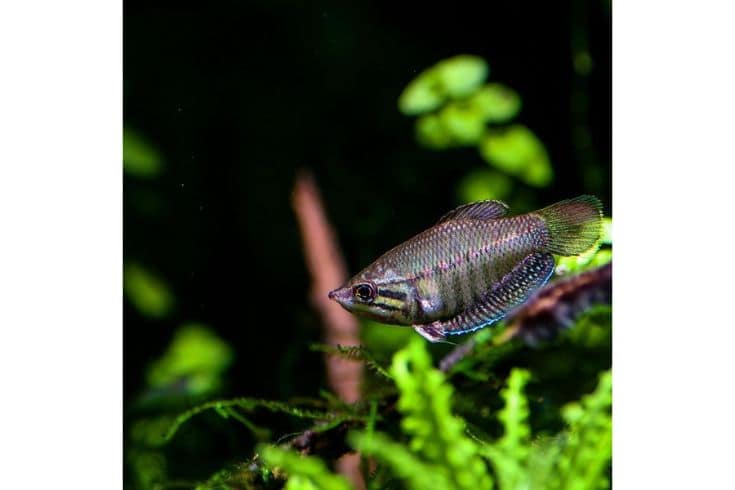
- Maximum size: 2 to 4 inches
- Life expectancy: up to 7 years
- Minimum tank requirement: 30 gallons
- Water temperature: From 77° to 84° Fahrenheit
- Care level: Intermediate
Chocolate gouramis, Sphaerichthys osphromenoides, are a gorgeous, cool tropical aquarium fish that experienced hobbyists might want to take on.
Unlike other gourami varieties, Chocolate gouramis can be challenging to keep healthy since they prefer slightly acidic water chemistry and warmer temperatures than other tropical community fish species.
These gouramis prefer a habitat that contains plenty of plants, which is challenging considering that the fish prefer acidic water conditions. You can keep Chocolate gouramis in small groups of their own kind, but they don’t mix with other gouramis of different species.
Chocolate gouramis can make a cool addition to a tank containing other small, peaceful types, such as rasboras, loaches, and danios.
32. Marbled Hatchetfish
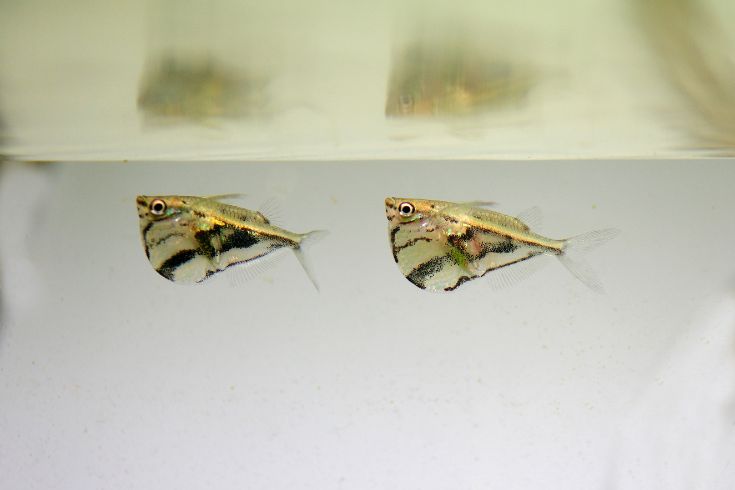
- Maximum size: 1.4 inches
- Life expectancy: up to 2 to 5 years
- Minimum tank requirement: 20 gallons
- Water temperature: From 76° to 79° Fahrenheit
- Care level: Easy
Marbled Hatchetfish, Carnegiella strigata, are surface-dwelling fish that originate from tropical blackwater habitats, where the light is dimmed by overhanging vegetation, and the substrate is covered with leaf litter.
These fish are a shoaling species that should ideally be kept in large groups of at least ten individuals to prevent them from becoming shy and withdrawn. Good tank mates for Marbled Hatchetfish are small, peaceful fish, such as Corydoras catfish, tetras, and Pencilfish.
Your aquarium should be biologically mature, with slow water movement and efficient filtering. You can replicate the fish’s natural environment by including plenty of caves, floating plants, and dense, bushy planting and ensuring that the water is soft and acidic.
The Marbled Hatchetfish you currently find in the trade are wild-caught, so we recommend quarantining them before adding them to your main tank.
33. Ropefish
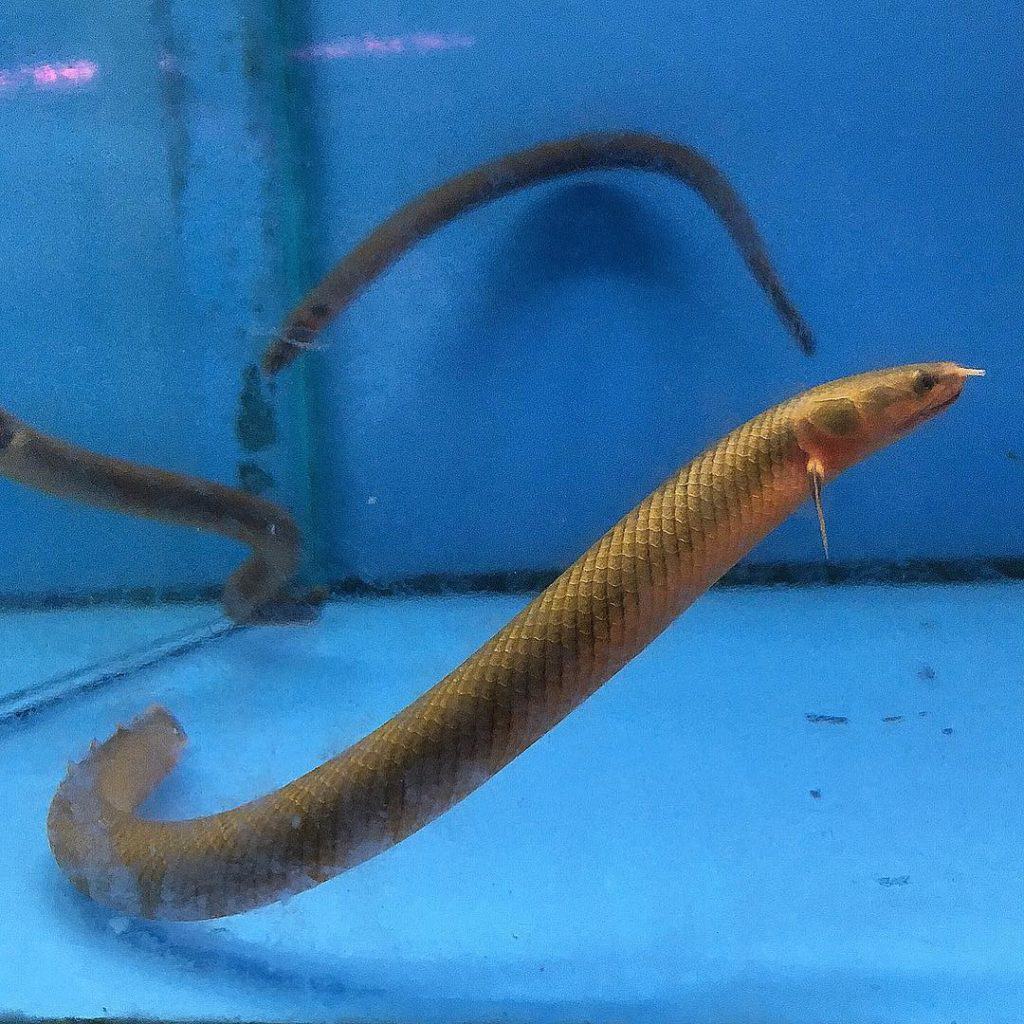
- Maximum size: in excess of 2 feet
- Life expectancy: up to 15 to 20 years
- Minimum tank requirement: 50 gallons
- Water temperature: From 72° to 82° Fahrenheit
- Care level: Easy
Ropefish, Erpetoichthys calabaricus, have relatives that date back millions of years, so if you choose one of these creatures for your tank, you’re keeping a living fossil! How cool is that?
These fish are nocturnal, get along with many other larger community species, and can live in freshwater and brackish conditions, so the possibilities for your setup are endless!
Ropefish come from western Africa, including Benin, Cameroon, and Nigeria, where they inhabit areas with plenty of dense vegetation. The fish have evolved a lung from their swim bladder, enabling the creature to breathe atmospheric air in addition to dissolved oxygen in the water.
That adaptation enables the fish to come out of the water for short periods to look for food on land, although they must remain moist. Interestingly, if the Ropefish cannot access atmospheric air and dissolved oxygen levels in the water are low, it’s likely that the fish would drown.
34. Elephant Nose Fish
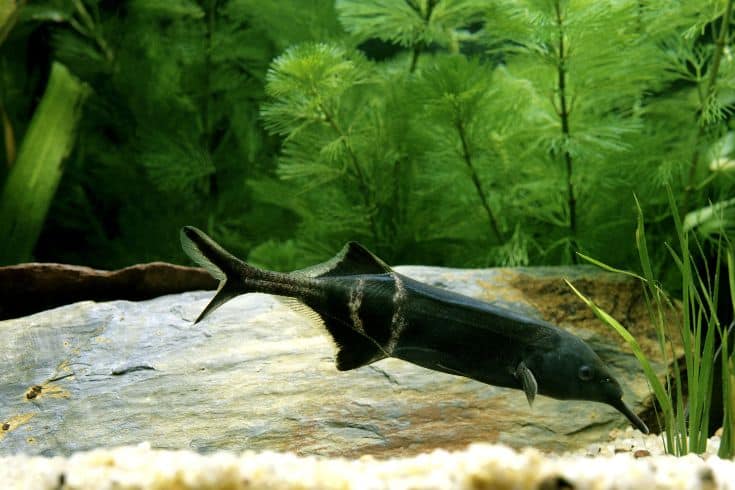
- Maximum size: up to 9 inches
- Life expectancy: 6 to 10 years
- Minimum tank requirement: 50 gallons
- Water temperature: From 79° to 82° Fahrenheit
- Care level: Intermediate
Elephant Nose fish have the scientific name Gnathonemus petersii and are tropical freshwater fish that come from Africa, mostly the Ogun River, Chari River, and Niger River.
Now, when it comes to cool, you must agree that these unusual fish are certainly right up there! The waters the fish inhabit have low visibility, largely because of the debris, silty riverbed, and the slow current.
In this poorly-lit habitat, the Elephant Nose fish has to negotiate an underwater obstacle course of numerous logs, branches, and roots to search for food. So, the fish has evolved a long nose called a Schnauzenorgan.
The Schnauzenorgan is highly sensitive and connects directly to the fish’s mouth, enabling the fish to find its way around. In addition, the Elephant Nose fish’s body is covered with receptors that pick up electrical currents given off by other animals, enabling it to avoid predators.
These fish are carnivores, and they can also be quite aggressive, so you must choose your tank mates with care.
35. Black Ghost Knifefish
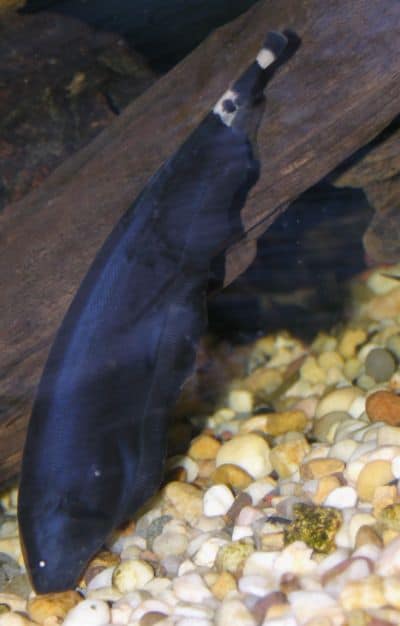
- Maximum size: up to 10 inches
- Life expectancy: 7 years
- Minimum tank requirement: 120 gallons
- Water temperature: From 75° to 82° Fahrenheit
- Care level: Intermediate
Black Ghost Knifefish, Apteronotus albifrons, comes from South America and is one of the most graceful aquarium fish in the hobby.
The fish has a long, undulating fin that runs along its underside and is equipped with a kind of in-built radar system that uses electrical currents given off by other fish to help the Knifefish navigate.
Although these are shy fish at first, they quickly become acclimated to their new environment and readily come out at night to feed. These fish are peaceful creatures that get along well with similar-sized tank mates and make a cool addition to any fish tank.
The good news for wild populations of Knifefish is that they are now being captive-bred in large numbers in Indonesia rather than being harvested from nature.
Generally, specimens of over 5 inches are wild-caught, whereas smaller fish are probably bred in and imported from Indonesia.
36. Koi Bettas
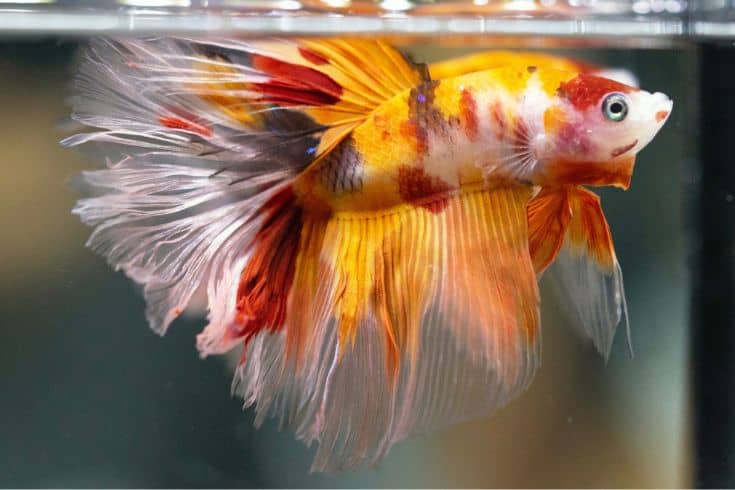
- Maximum size: up to 3 inches
- Life expectancy: 2 to 3 years
- Minimum tank requirement: 5 gallons
- Water temperature: From 76° to 80° Fahrenheit
- Care level: Easy
The Koi betta is also known as the Marble betta and is essentially a color morph of the familiar and universally popular betta splendens.
Male bettas of all varieties are notoriously aggressive fish that can only live alone or with a few suitable tank mates. If your Koi betta will tolerate other fish in his kingdom, he will be happier physically and mentally, which helps to keep stress at bay.
If you go shopping for a cool Koi betta, you’ll have six varieties to choose from, including:
- Galaxy
- Fancy
- Candy
- Samurai
- Tiger
- Nemo Palkat
Within those varieties, you’ll find different tail types, including half-moon and crowntail, as well as combinations of variants, such as Candy Galaxy Koi betta.
Of all the Koi betta varieties, the Samurai is the rarest, with beautiful dragon scaling combined with marble, and comes in lots of different colors.
37. Bichir
- Maximum size: up to 23 inches
- Life expectancy: 10 to 15 years
- Minimum tank requirement: 90 gallons
- Water temperature: From 72° to 82° Fahrenheit
- Care level: Intermediate
Bichirs belong to the Polypteridae family of fishes, a sister family to ray-finned fishes. These fish come from tropical Africa and the Nile river system, where they live in swampy, shallow estuaries and floodplains.
As such, these nocturnal fish have a pair of lungs, and they also possess electroreceptors known as the Ampullae of Lorenzini, which the Bichir uses to detect prey.
These are large, carnivorous predators that need a large tank to accommodate them. Although you can keep Bichirs in a community tank, small fish are not suitable as tank mates, as they could become lunch for a hungry predator.
That said, large, semi-aggressive fish can make suitable tank mates for these swimming fossils.
38. Electric Blue Jack Dempsey
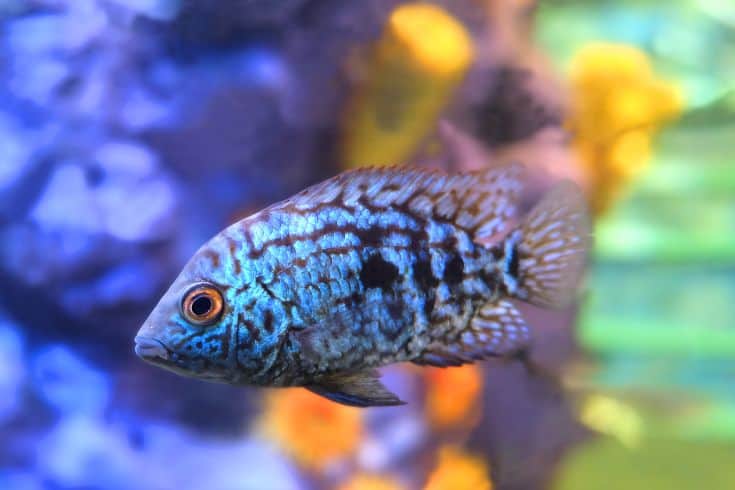
- Maximum size: up to 8 inches
- Life expectancy: 10 to 15 years
- Minimum tank requirement: 50 gallons
- Water temperature: From 68° to 86° Fahrenheit
- Care level: Easy
Electric Blue or Powder Blue Jack Dempsey, Rocio octofasciata, brings an incredible pop of bright blue color to any setup.
For years, it was thought that the fish was a hybrid of a New World cichlid and a Jack Dempsey cichlid. However, it’s now widely believed that the brilliant blue hue is a natural mutation within the original species.
Electric Blue Jack Dempsey fish are quite new to the hobby and are now selectively bred to produce hardier, healthier fish than the original specimens. These fish are usually more peaceful in nature and smaller than their “wild color” relatives.
Jack Dempseys have a habit of rooting through the substrate, which can disturb plants, so we recommend using plant species that you can fix to rocks or driftwood.
To maintain the fish’s brilliant colors, you should feed them a varied, high-quality diet.
39. Sulawesi Shrimp
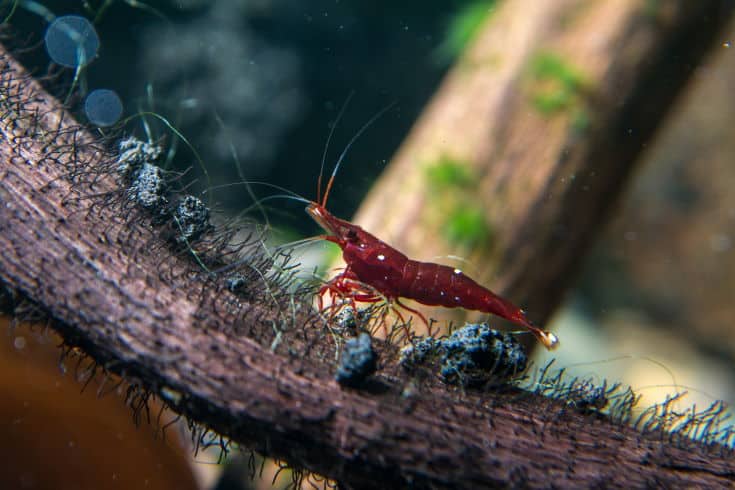
- Maximum size: up to 1 inch
- Life expectancy: up to 2 years
- Minimum tank requirement: 10 gallons
- Water temperature: From 78° to 88° Fahrenheit
- Care level: Difficult
Sulawesi shrimp, Caridina dennerli, are a relatively new dwarf shrimp to the hobby, having been discovered as recently as 2007, and are highly sought-after in the trade.
These shrimp come from the Sulawesi region of Indonesia, where they live in two ancient lakes where water conditions are unique. That can make replicating the shrimps’ preferred conditions in your home aquarium somewhat challenging, especially since the shrimp don’t tolerate fluctuations in water parameters.
The Sulawesi shrimp is one of the coolest head-turners in the hobby, especially for invertebrate fans. These active little shrimp are a vibrant red color, covered with a display of brilliant white spots. Some shrimp have white antennae, white front legs, and white tails, too!
40. Hillstream Loach
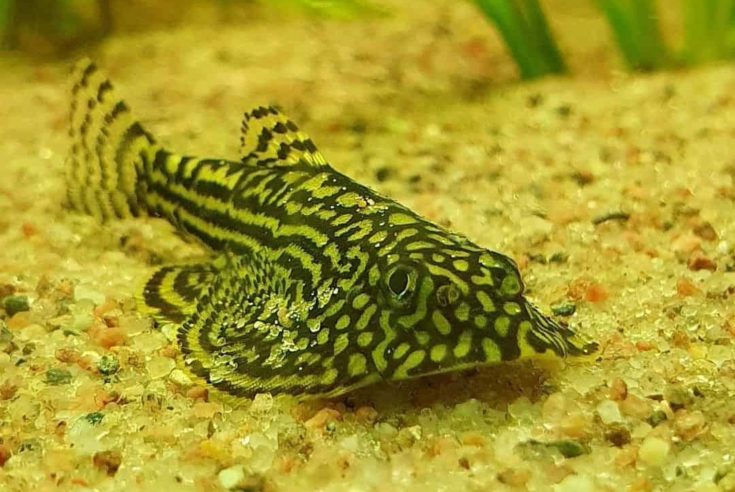
- Maximum size: up to 3 inches
- Life expectancy: up to 10 years
- Minimum tank requirement: 50 gallons
- Water temperature: From 68° to 72° Fahrenheit
- Care level: Easy
The Hillstream loach has the scientific name Sewellia Lineolata. These cool fish come from the fast-flowing streams of China, Southeast Asia, and India, where they live in fast-flowing streams.
The Hillstream loach uses its sucker mouth to cling to rocks or spends much time rummaging through the stream substrate for scraps of food, including algae, insect larvae, small worms, and the like.
These loaches often live in small groups and can make an eye-catching addition to your aquarium. That said, you must remember that the loaches prefer cooler water with a rapid flow rate, so be sure to choose tank mates that enjoy similar conditions.
Good tank mates for Hillstream loaches are White Cloud Minnows, Celestial Pearl danios, and Zebra danios.
Sadly, these cool fish are in decline in the wild primarily due to habitat destruction, and they are listed on the IUCN Red List as vulnerable.
41. Heckel’s Thread-finned Acara
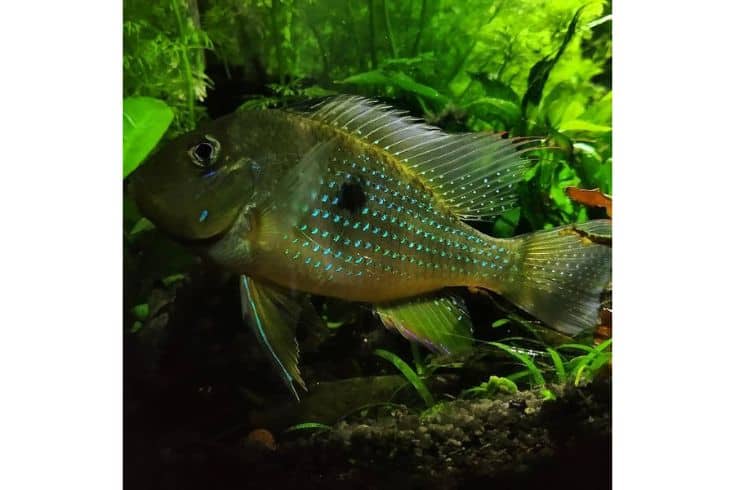
- Maximum size: up to 9.3 inches
- Life expectancy: up to 10 years
- Minimum tank requirement: 40 gallons
- Water temperature: From 73° to 79° Fahrenheit
- Care level: Intermediate
Heckel’s Threadfin Acara, scientific name Acarichthys heckelii, is rarely seen in the home aquarium and could make a totally cool addition to your setup.
These semi-aggressive fish originate in the tropical Amazon and Essequibo basins of South America but are now also established in southeastern Asia.
You’ll need a mature, spacious tank for these unusual fish. The substrate should be soft and sandy to accommodate Threadfin Acara’s habit of sifting through the substrate for food scraps. These fish enjoy a habitat with lots of caves, rocks, driftwood, and tangled roots that form natural barriers.
Like most cichlids, the Threadfin Acara is likely to uproot plants, so stick to robust species, such as Anubias or Java Fern, that you can cultivate attached to pieces of wood.
One downside of keeping these rare fish is a price tag to match their amazing looks. You can expect to pay upward of $50 for a single specimen! That’s not so cool.
Caring For A Freshwater Fish
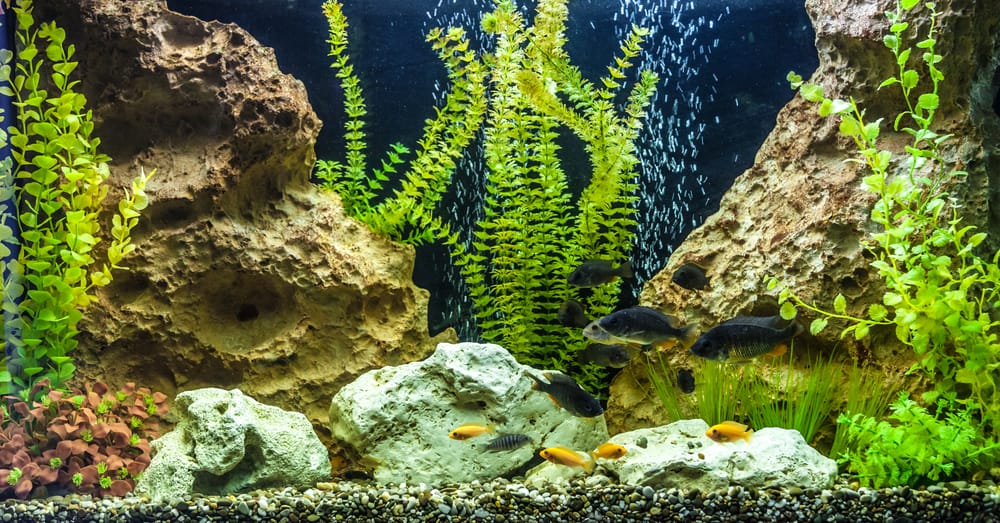
Your freshwater aquarium is an enclosed ecosystem that needs careful maintenance to ensure that the environment is healthy for the inhabitants. You can read an in-depth article at this link, which explains how to care for a freshwater aquarium. In the meantime, here are a few basic pointers so that you know what you’re taking on.
The Nitrogen Cycle
When you set up a new aquarium, it’s essential that you cycle the tank before you put fish in it.
Your aquarium filter contains mechanical and biological elements, and some have chemical elements too.
The biological part of the filter system contains certain species of beneficial bacteria that process the harmful substances that are released during the decomposition of fish waste, uneaten food, decaying plant matter, and general detritus. The Nitrogen Cycle, as it’s called, can take up to six weeks to kick in properly and is absolutely crucial for a safe, healthy tank.
Introducing New Fish To Your Aquarium
Even though you’re super-excited about buying your new fish, don’t just tip them straight into your tank!
Quarantine
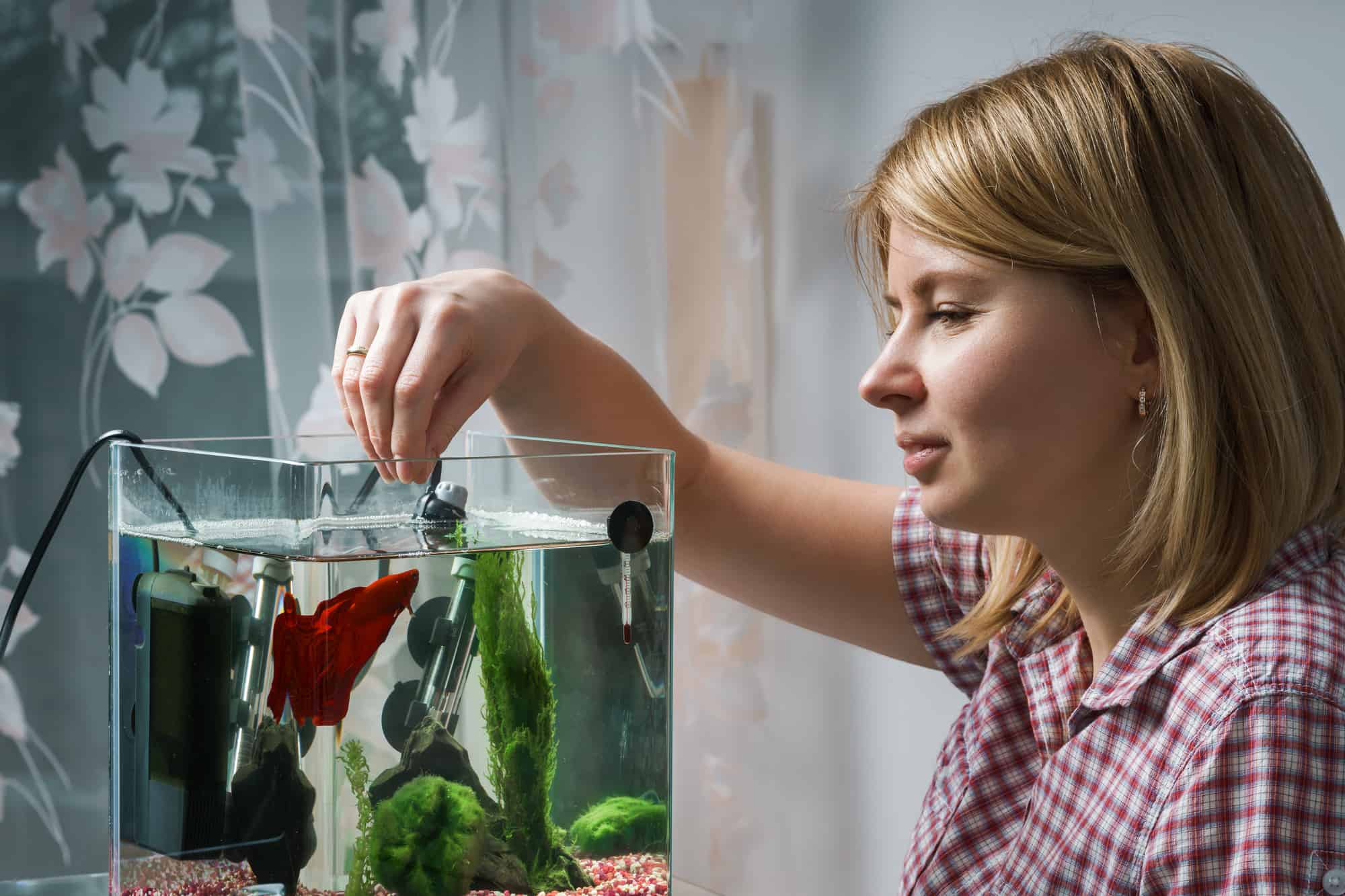
All livestock, plants, and decorations can carry diseases, parasites, and bacteria that you absolutely don’t want in your display aquarium. For example, a few years back, I bought four beautiful dwarf gouramis and put them into a quarantine tank. Thank goodness I did! Those fish came in water that carried a whole bunch of snails that weren’t visible to the naked eye until they began to grow.
So, you should always put any new fish into a separate quarantine tank for at least two weeks before adding them to your main tank. During that time, observe the fish for signs of ill health and treat problems accordingly. When you’re happy that the fish are healthy, you can put them into your display tank.
Plants and decorations should be rinsed in tank water containing antibacterial treatment to kill off any nasties and then added to your main aquarium.
Acclimating New Fish
All species of fish are sensitive to sudden temperature and environmental changes, and for that reason, it’s essential that you acclimate your fish before putting them into your tank. Also, fish are highly susceptible to stress.
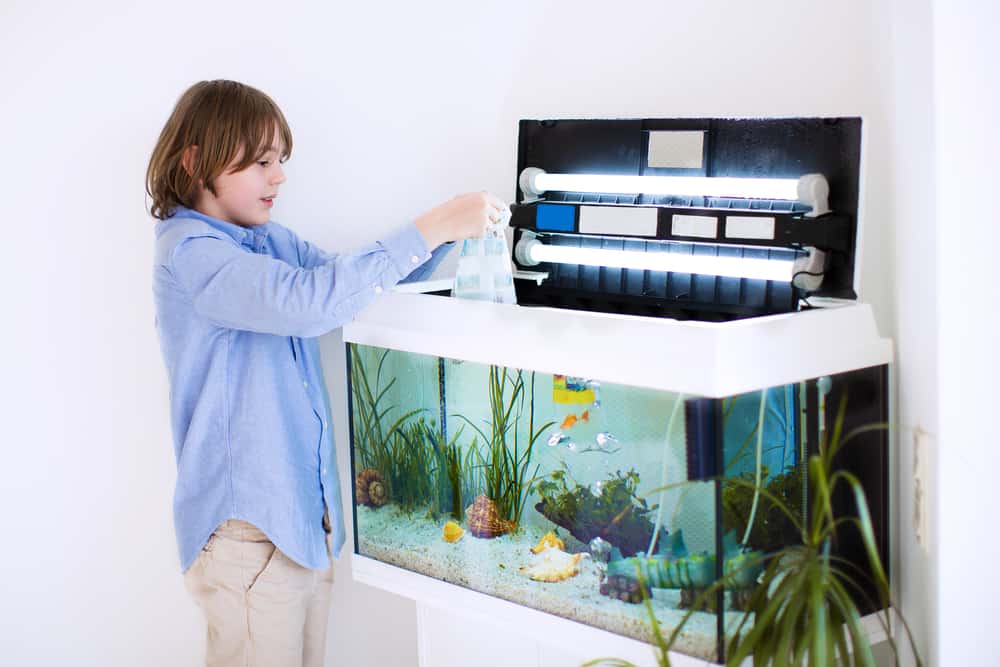
By the time you buy new fish from a fish store, those little guys have endured the stress of transport, been kept in crowded conditions in a store display tank, and then been bagged up and taken back home with you.
Before you add the fish to your tank:
- Switch off the tank lights.
- Float the bag containing the new fish on the water surface for ten to 15 minutes so that the water temperature equalizes. During that time, open the top of the bag and fold it open to allow air in so that the fish don’t suffocate.
- Check the pH of both the tank water and that in the bag. If the difference between the two is less than 0.3, add a half cup of aquarium water to the bag every 15 minutes for one hour. If that difference is .4 to 0.8, continue to do that for two hours.
- Remove the fish from the bag using a net and carefully put them into the tank, discarding the water in the bag.
Aquarium Maintenance
Once your tank is set up, you need to keep it clean and well-maintained.
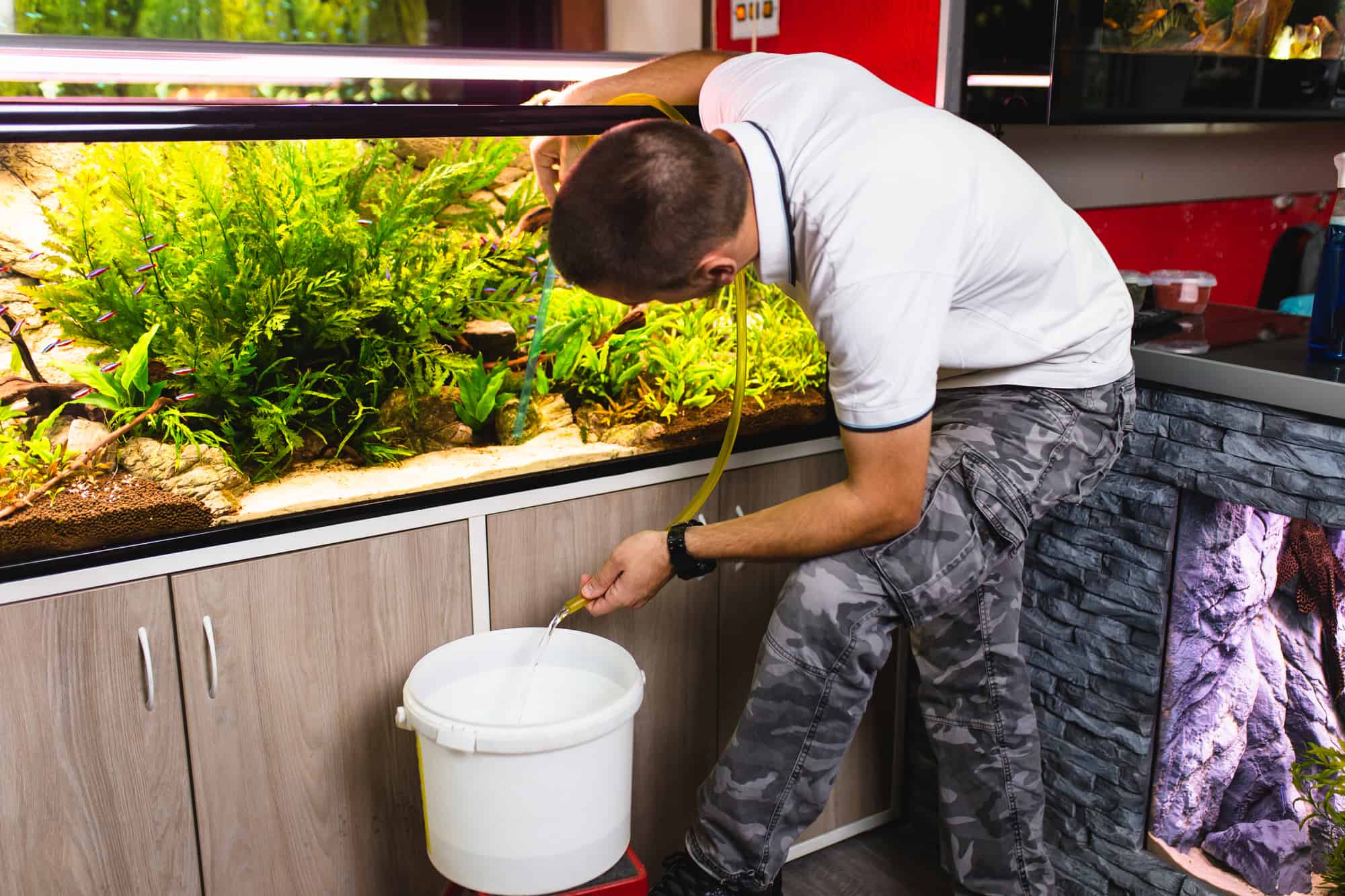
Keep an eye on the water temperature to make sure that your heater is working correctly, and check the water chemistry every few days. The levels of ammonia and nitrite should be zero, and nitrate levels should be no more than 20 ppm (parts per million). Levels that are too high could indicate a problem with your filter system or potential overstocking of the tank.
Every week, carry out partial water changes of up to 30% and vacuum the substrate to remove fish waste, leftover food, etc. Use an aquarium magnet to clean algae from the glass, remove dead leaves, and trim plants as required.
Once a month, clean the filter system and replace cartridges as necessary.
FAQs
In this section of our guide to the 41 coolest fish on the planet, we answer some of your questions.
Q: Which colorful freshwater fish do you think is the coolest?
A: So, we think the coolest, most colorful freshwater fish out there is the Koi betta.
These gorgeous fish certainly add a huge pop of color to your tank and come in many different forms and color combinations. What makes these bettas even cooler is their intelligence.
Not only are Koi bettas great to look at, but you can teach them simple tricks too!
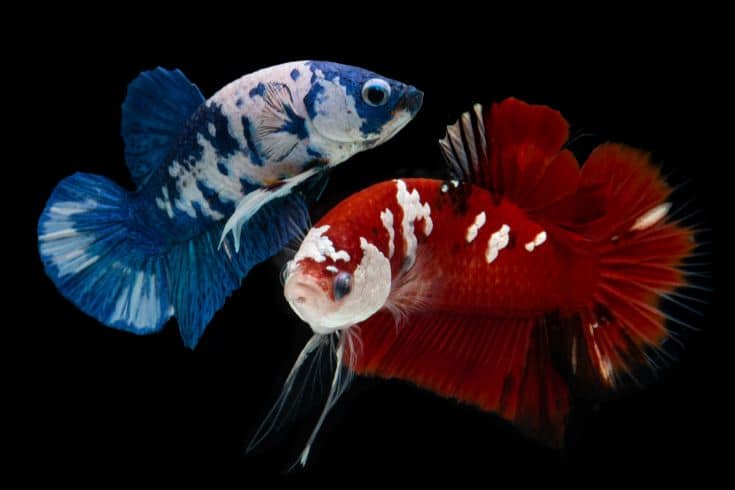
Q: What is the best combo for a colorful freshwater fish tank?
A: When choosing a selection of cool fish for a freshwater tank, it’s not just a matter of what colors look best! It’s essential that you pick fish that share the same water requirements. For example, some fish prefer cooler water, whereas others like it much warmer.
Make sure the fish you choose will get along together and will be happy in a community setup.
Finally, try to find fish that enjoy the same dietary requirements and share similar preferences when it comes to habitat.
Q: Which is the best cool fish if you are a beginner?
A: Again, I suggest that a betta fish would be the best choice of a cool fish for a beginner.
Bettas are quite hardy, can live in a small tank, and can be kept with a few small, peaceful fish or inverts. There are lots of different varieties, colors, and tail forms to choose from, too.
Q: What is the most exotic freshwater fish?
A: Flowerhorn cichlids and Discus are both exotic-looking freshwater fish that can look extremely cool in your tank.
That said, Flowerhorns will eat small fish and shrimp, so you should keep them with suitable tank mates that won’t finish up as lunch!
Final Thoughts
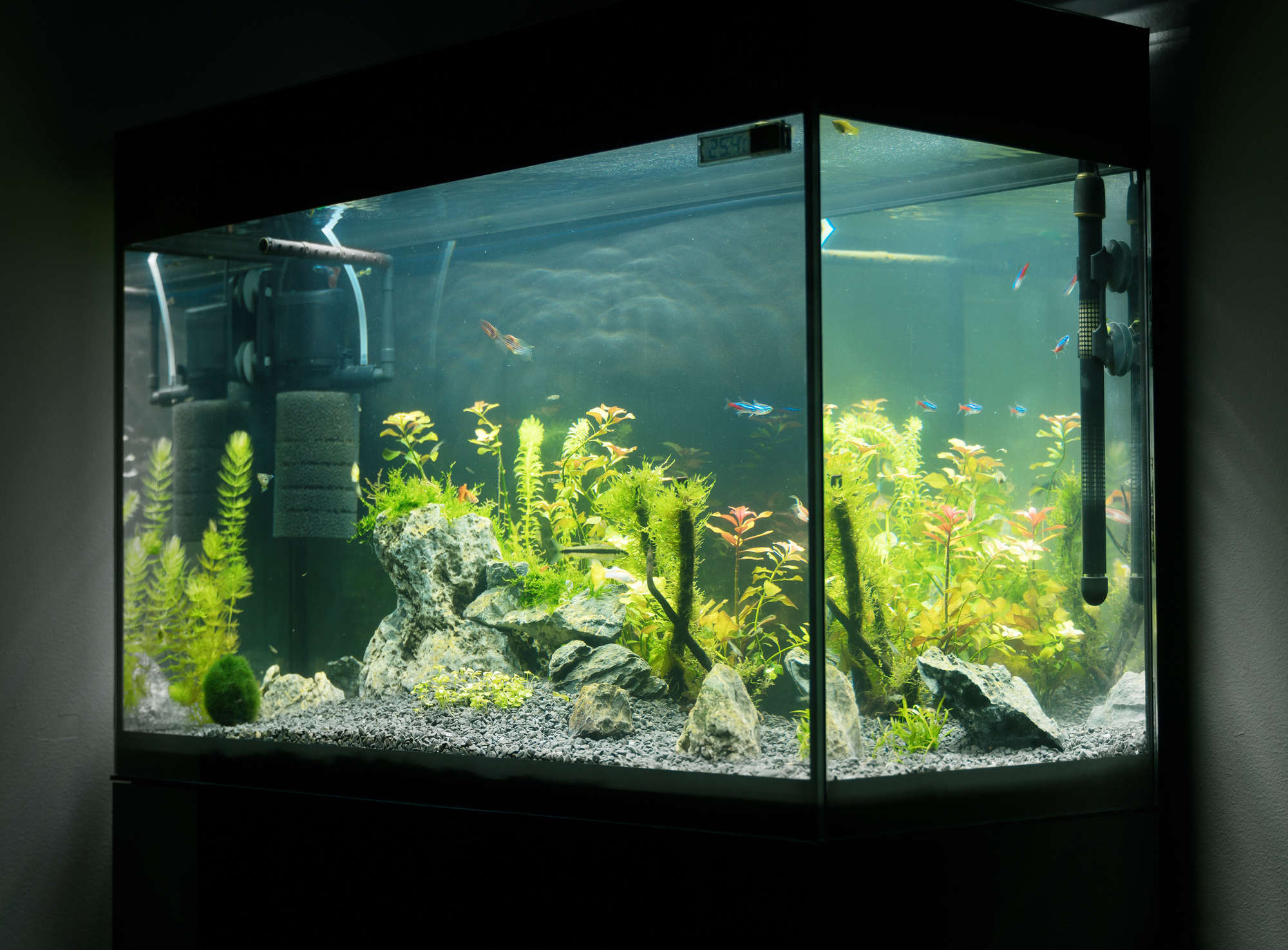
We hope you enjoyed the list of our favorite cool fish species. If you did, please remember to share this article with your friends!
Most of the fish species that we included in our list are suitable for beginners, and many make a great addition to a peaceful community tank, so we reckon that there’s something for everyone here.
That said, are there any other cool fish that we didn’t mention? Don’t be shy! Tell us all about the fish that you think deserve to make the list in the comments box below.
Check out our infographic, and don’t forget to share!
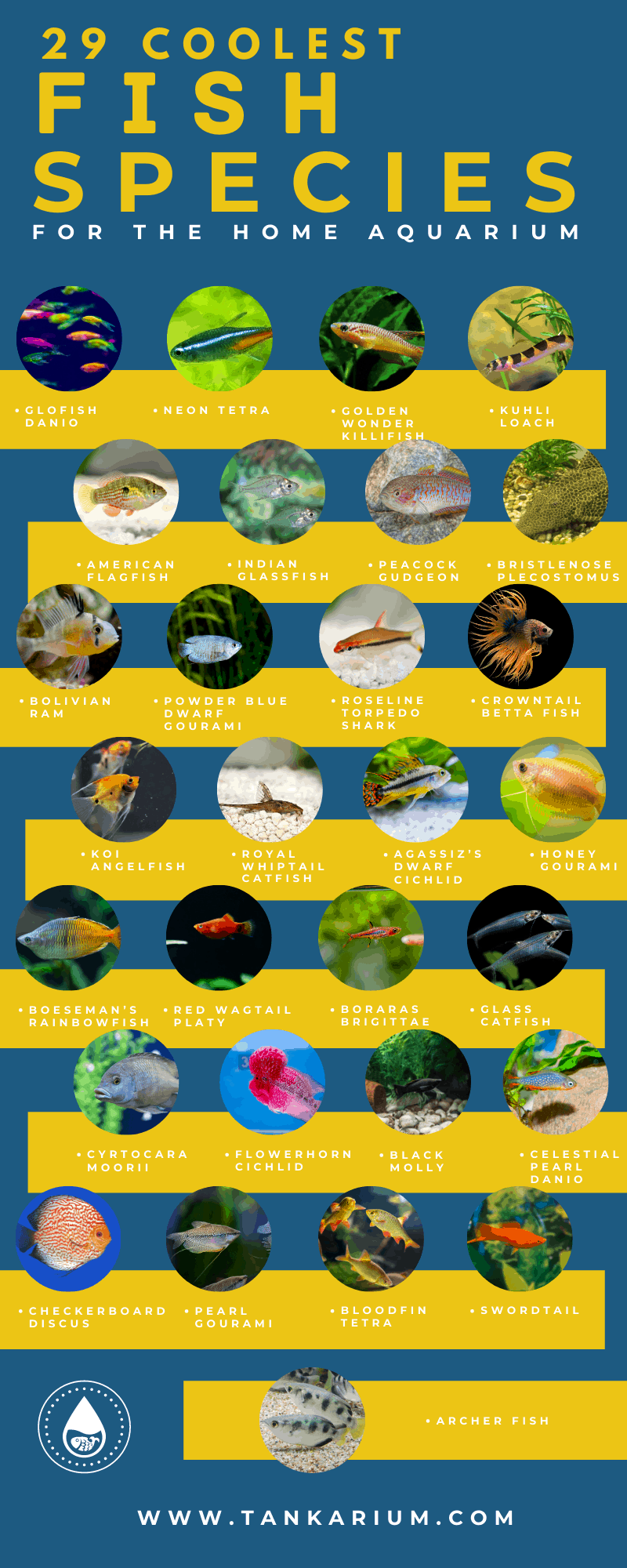
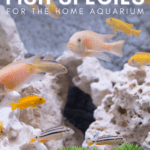
My tank is a new setup ( 15ga. Flex ). The question is this. Cloudy water. The 1st time I used water clarifier and it solved the problem. About 3 days later it came back. I only have 2 fish in the tank at this time. I have fed tropical flake food and before this happened just a couple pieces of Tetra blood worms. So can you tell me what might be causing this.
Thanks Randy
Bad news Randy! Your fish most likely have Pork’s Disease. Only having two fish and your tank gets cloudy and does not respond well to a water clarifier is a clear sign of Pork’s. Unfortunately, there is no cure for Pork’s Disease and it is fatal.
If I were you, I would start making arrangements for the burial of your fish.
My condolences.